2014 was an important year in the life of MAME.
Some of the improvements that were made throughout the year resulted in a number of people saying that MAME now covered every memorable game from the 80s and 90s and was therefore essentially complete. This is of course not really an accurate reflection of where in the project life we are, but as a large percentage of our current user group only have fond memories of the most popular games in the 80s90s period it is one that is easy to understand when you look at the progress made (although even then we still have significant holes in what we emulate, Sega’s immensely popular 3D systems for example are not well represented at all yet)
It’s probably worth putting the age of MAME into perspective at this point too. If we assume MAME was ‘born’ in 1997 (February 5th 1997 was the first release under the name ‘MAME’) then at that point Pacman, one of the first games that MAME emulated was 17 years old at the time (it was released in 1980) Fast forward to 2014, and MAME is now 17 years old! The original version of MAME is as much a classic piece of software as Pacman was when MAME was first released, I find that mindblowing. It also puts something else into perspective, people who were fond of unemulated games from the 1990s (anything before 1997) have actually had to wait longer to see those memories come to life in MAME than people had to wait for Pacman, we’re a very old project now, yet we continue to improve and evolve.
Enough introduction, let’s start with what the majority considered to be the biggest news of the year.
Seibu
Raiden 2
This is the one that really got people talking, it’s from 1993, so 21 years ago, and until the progress made last year was still one of the most high profile cases of unemulated protection. With the emulation of Raiden 2 it was many Shmup fans declaring MAME to be complete and fully representative of the most important eras of the genre, saying that a book had finally been closed.
One of the best things about emulating things is the history you uncover, the little forgotten facts. The best known versions of Raiden II are the PSX and PC ports, these have been accessibly by the masses for years, so they’re the version of the game most people are familiar with. In the arcades however there were a couple of other versions of Raiden II, the most famous one being the ‘Easy’ version, identifiable by the solid black background on the high score screen. This version has some different enemy placements (including enemies that don’t usually appear until much later on present in the first stage) but with the overall difficulty toned down somewhat. The tint of the fade effect between scenes has also been changed.
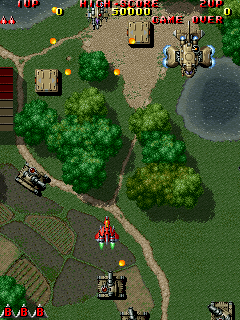
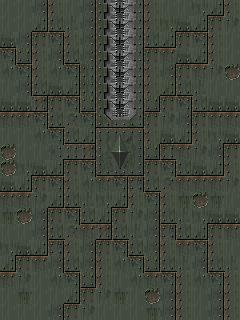
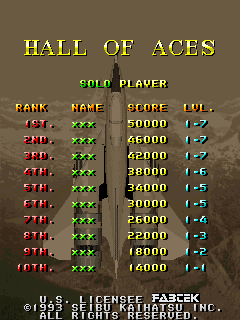
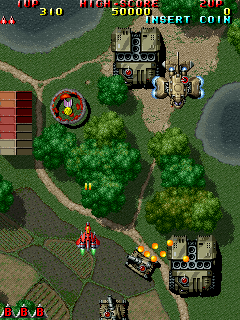
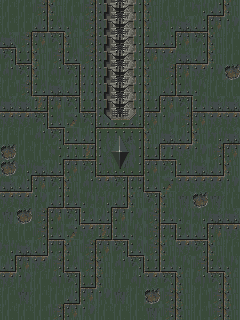
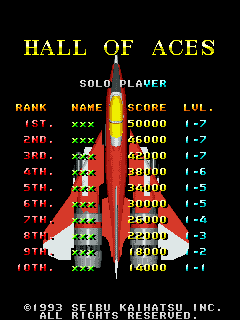
A much rarer version, and one nobody had ever even mentioned prior to it being emulated is a much, much harder version of Raiden II, oddly enough running on a Raiden DX PCB. This version throws many more bullets at you, all moving with a much higher velocity, again enemy placements are modified a bit – the tanks you find on the very first bridge are of a higher level than those in the regular release for example. Unlike the easy version there are no obvious clues that this version different until you start playing it.
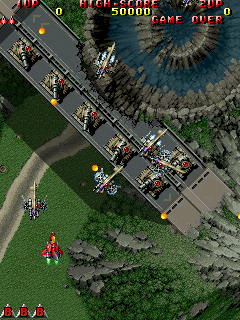
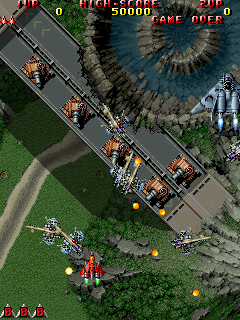
Raiden DX had less interesting variations, it was noted that the previously dumped ‘Japan’ version was actually a ‘Korea’ set, and the Japan version was later dumped, and, as expected is a different code revision with the rapid fire / auto-fire feature not present (and so is more difficult to play) but otherwise I think enemy placement is the same between all Raiden DX versions.
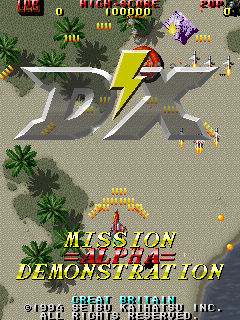

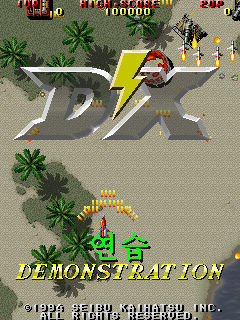
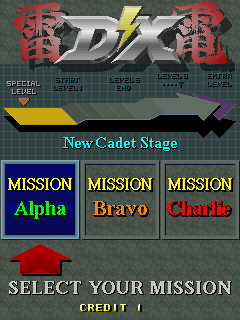
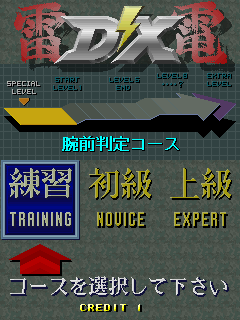
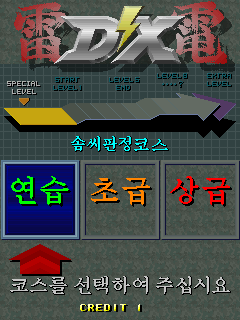
Truth be told the book really isn’t closed yet, while the protection code we have holds up well for Raiden 2 (including handling some very carefully determined edge cases correctly) it does not yet hold up entirely for other Seibu games using the same protection chip, and there are a couple of questions over a few minor elements even in Raiden 2 (although nothing game breaking or worse than you might have found in an official port of the game anyway)
There is actually an arcade version of Raiden II that is better emulated, although it’s a worse version of the game in the first place. Here I’m going to introduce to you one the stranger releases of Raiden II, a ‘New’ version running on a V33 based board with revised protection. The board in question is actually a 2-in-1 board, and contains the code for both Raiden II NEW, and a version of Raiden DX with Gold themed graphics.
These versions of the games are, as stated, actually the most accurately emulated due to the reduced protection, however, you’re unlikely to actually want to play them because the board has a butchered sound system. What this means is all the music and sound effects are pumped out through a single OKI M6295 chip at sub-bootleg quality. The Raiden 2 New release also has the stage order swapped around meaning the difficulty curve is uneven and scene transitions seem illogical to the point of the 2 cut-scene sequences being removed entirely. Why, Seibu, Why?
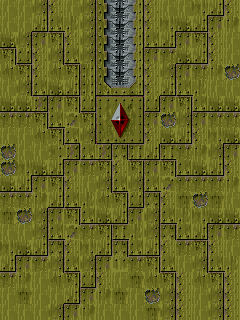
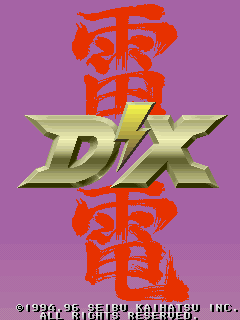
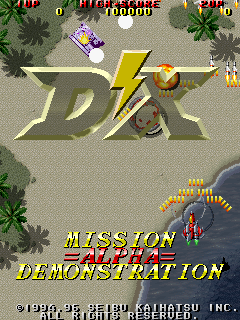
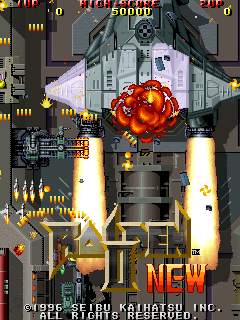
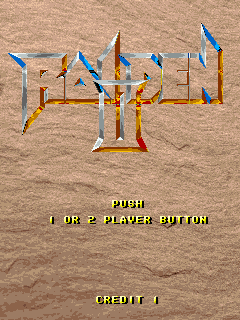
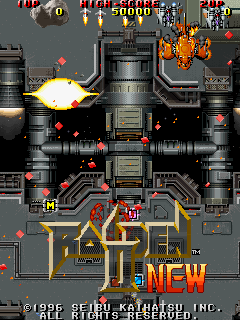
Zero Team
While the majority of the hype and excitement centred on Raiden 2 I actually think the emulation of Zero Team was more important because while Raiden 2 had ports to the Playstation and PC already (not perfect ones, but very acceptable ones) Zero Team was never ported.
The original Zero Team doesn’t actually work yet, it’s one of those cases that shows our handling of the ‘Seibu COP’ protection device is still imperfect, but we were lucky enough that Seibu did several re-releases of the game on hardware with weaker protection (the same reduced protection as the ‘NEW’ Raiden 2 version above but without the butchered sound hardware)
Two versions of Zero Team are fully playable, the most interesting of these is Zero Team 2000, which appears to be a faithful release of the original 1993 game on the updated hardware. The level order is correct, 4 player mode can be enabled in service mode (the board uses an EEPROM instead of dipswitches) and basically everything works how you’d expect it to work and because the sound system was left alone it all sounds exactly like the original release too.
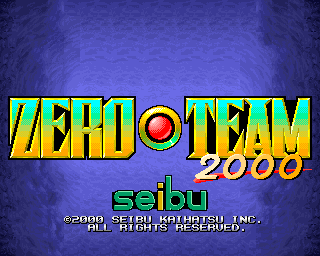
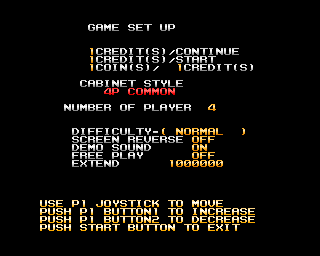
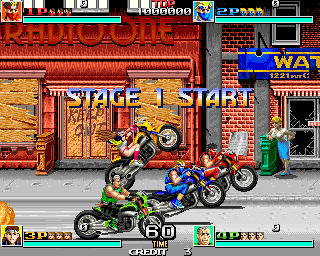
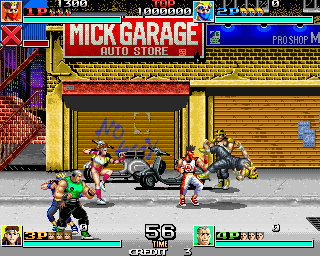
The other re-release of Zero Team that can be considered working is New Zero Team, an earlier re-release from 1997 that, like the ‘New’ Raiden II release, inexplicably swaps the first stage with one of the others, leaving the whole game feeling out of sequence. It also lacks 3 / 4 player support. This is actually one of the most common PCBs for the game, and the one most people are familiar with, but unfortunately the changes mean it simply doesn’t play as well.
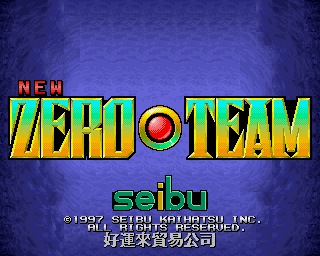
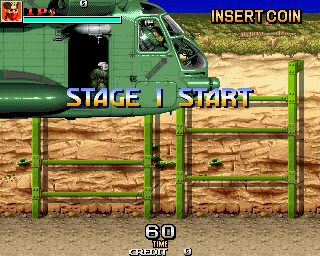
The emulation of Raiden 2 / DX did prompt a number of people to check the program revisions on their PCBs, so we ended up with additional regional clones too, although aside from the ones I’ve mentioned most of them appear to play the same.
Several other Seibu games were improved by these changes, although not to the point of working ‘properly’ I’ll cover these later.
Apple
While Apple is now considered one of the most influential hardware manufacturers around that was not always the case. One of several mis-steps they made was with the Apple /// (aka Apple 3), a machine that endured numberous manufacturing woes, and ended up with barely any software being created for it.
The majority of the software that does exist for the machine is programmed in BASIC, and does not even escape the monochrome text-based graphic display, most of it is fragile and will even crash with syntax errors if you give it the wrong input. For that reason actually making worthwhile screenshots to show this progress is difficult, however, one game, Cap’n Magneto, actually uses custom graphics, it was actually a commercial game back in the day, but was re-released as PD sofware later.
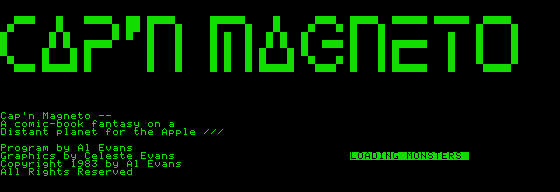
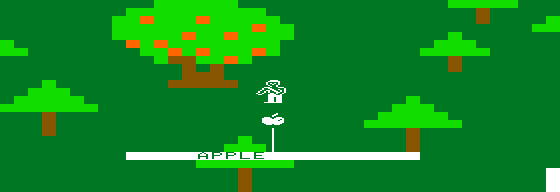
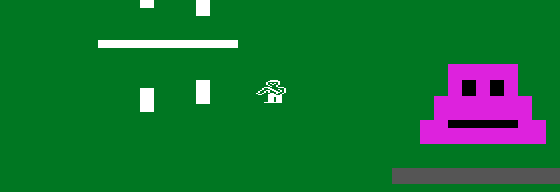
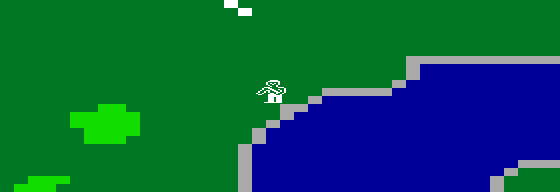
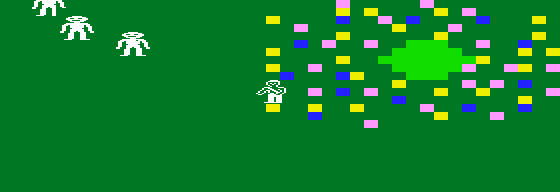
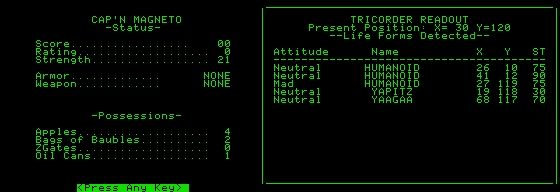
It might seem strange that I’ve jumped straight from the Seibu work everybody has been wanting to see for years to a machine barely anybody even remembers but my personal feeling is that both are of equal importance in terms of emulation, but for vastly different reasons.
The Rare
As is increasingly the case the most interesting aspect of MAME development is when something rare or previously unknown is discovered. While topping the prototype stash found in 2013 is no easy task the finds made in 2014 have also been moments to savour.
Exceedingly Uncommon
Mega Phoenix was an addition early in the year that proved the existence of the long rumoured ‘Dinamic’ arcade platform, while also possibly shedding some light on the origins of Little Robin which turned out to be using the same code on the TMS graphics processor as Mega Phoenix.

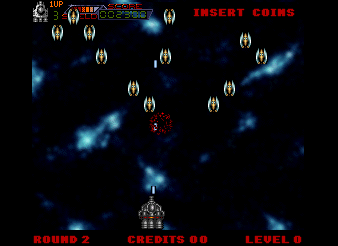
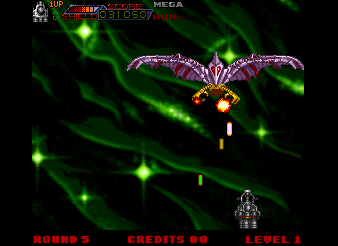
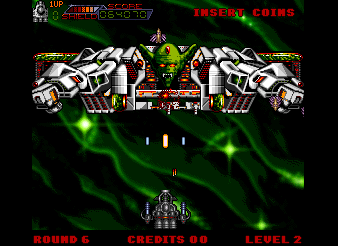
Ken Sei Mogura has appeared on every CPS1/2 games list for as long as I can remember. For many years it was a complete mystery, but in more recent years videos of the game taken from arcades in Japan surfaced on YouTube. Due to the nature of the cabinet getting a dump was always going to be tricky, but fortune was on our side in 2014 when one showed up in the UK. In the end this was an amazing find because it was a complete cabinet, not loose boards, and it showed that the game was only using a CPS1 board for the video, with a different PCB running the game logic, had we ended up picking up random boards on auction sites instead those could have easily been separated leaving us confused and with something we were unable to emulate.
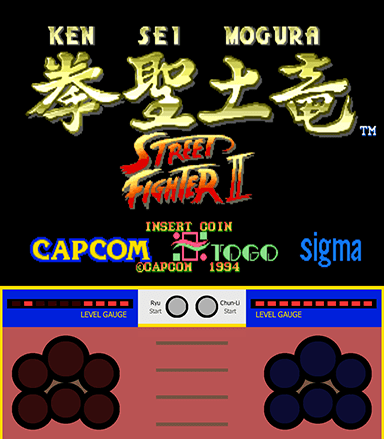
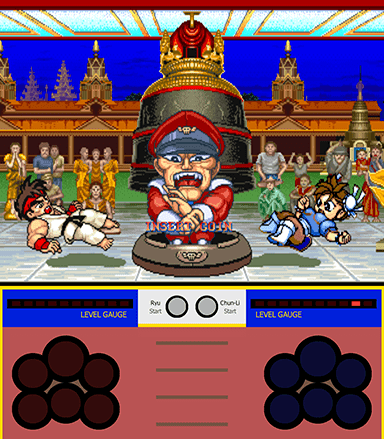
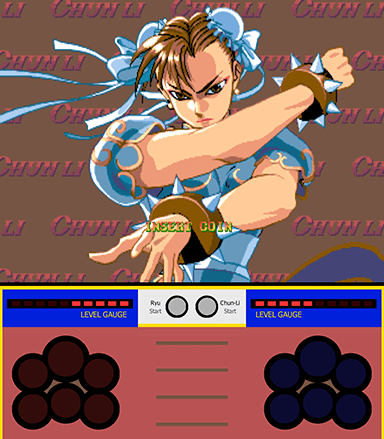
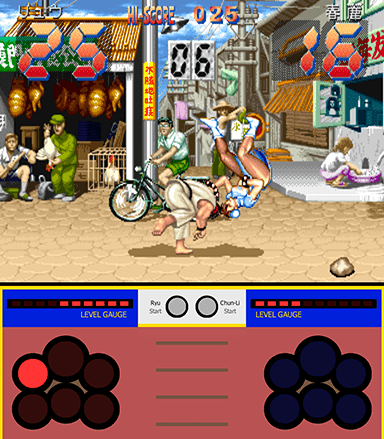
Music Ball is one that was dumped last year, but only decrypted this. It’s a companion game to Speed Ball, possibly unreleased. For some reason the set we have has all the copyright details and title logo either hacked out, or simply never finalized.

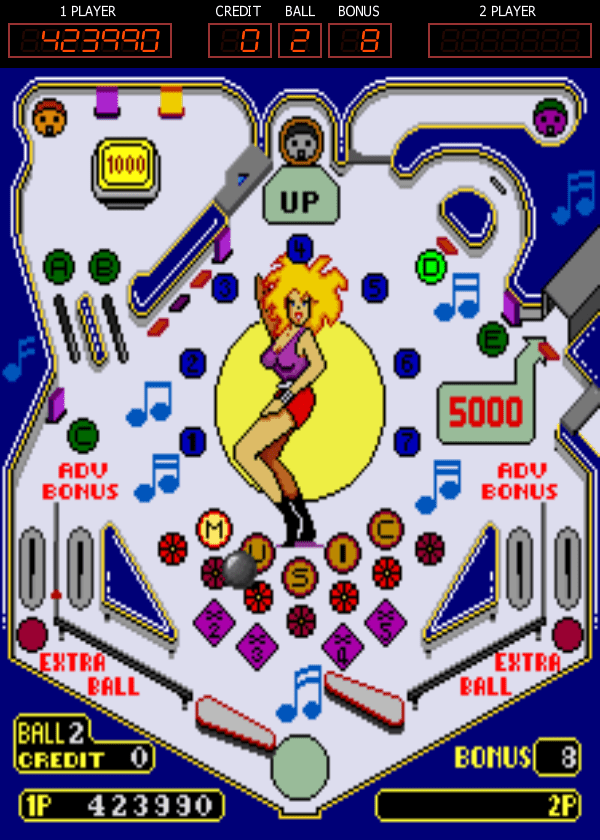
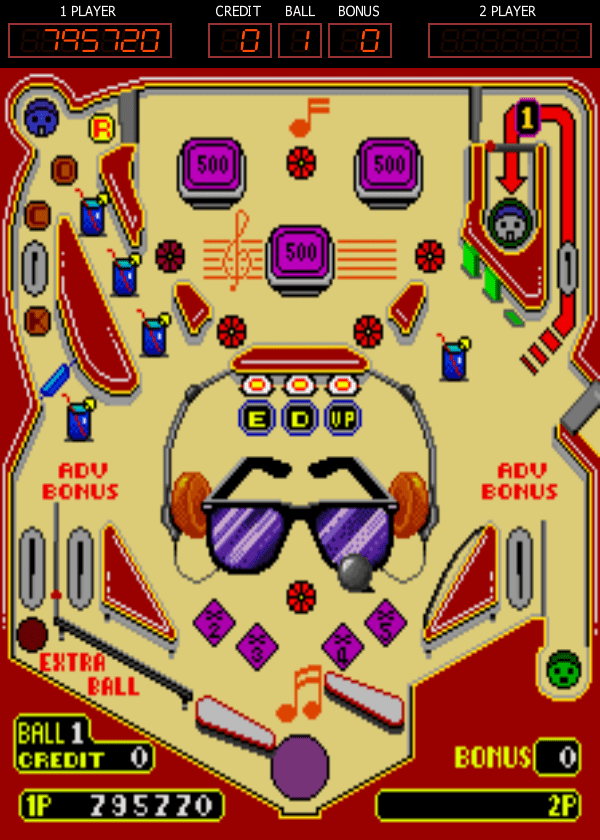
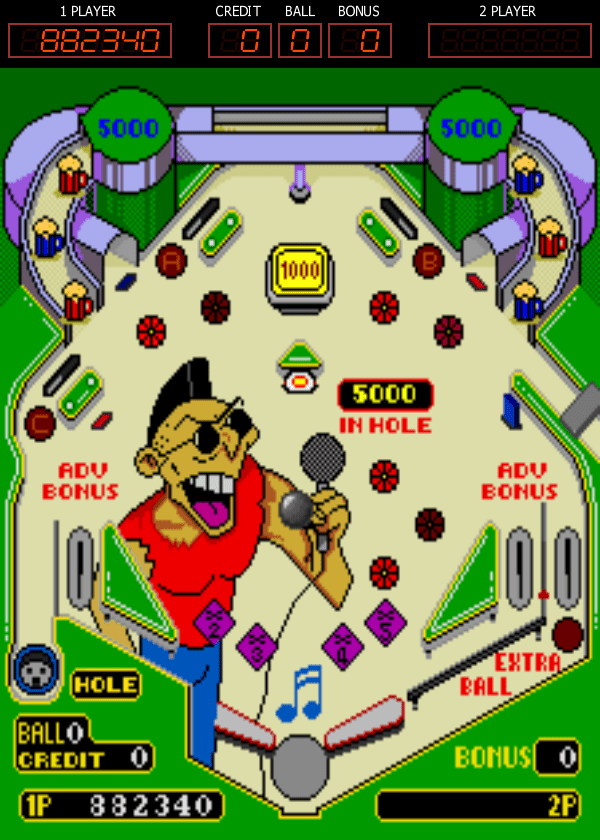
While the game is mostly just a reskin of Speed Ball it does differ in several ways, most noticeably you can’t select the stage, you must progress through the warps to reach the other tables (and upon death you’re returned to the first one) It also has new music, as maybe you’d expect from a game called Music Ball.
Wyvern F-0 finally arrived in MAME to surprisingly little fanfare which surprised me because prior to this it was one of the most talked about ‘Rare Taito Games’.
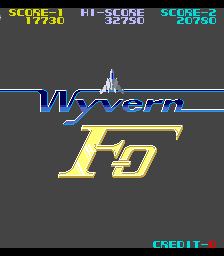
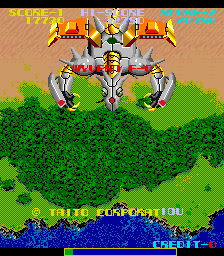

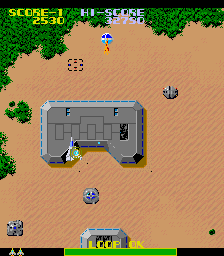
Arcadia
A large number of Arcadia (Amiga based arcade) games were found, dumped and added in 2013, however, some of that work spilled over into 2014. Aaargh is a ‘Rampage’ inspired destroy-em-up. It was released on both the Amiga and PC, but the home Amiga version lacked the 2 player mode, something that is present in the arcade version. Interestingly this game doesn’t actually run with the Arcadia bios, and can’t be used in a multi-game setup, all the other Arcadia games do (although I’ve heard that Leaderboard uses a similar configuration, so I’m less sure what’s going on there)




There was other Arcadia progress beyond Aaargh thanks to Amiga emulation improvements coming from the MESS side of the project. The game ‘Space Ranger’ has been marked as ‘Working’ in MAME for many years, it’s a defender style game where you have to rescue creatures from a landscape that is under attack by aliens. In all old MAME versions the game was basically unplayable because the 2nd button didn’t work, it was mapped in the driver, but due to some missing low level details of the Amiga emulation it simply didn’t function and should never have been marked as working. Thanks to the work done that is no longer the case, so I’m considering it to be a new working game for 2014.
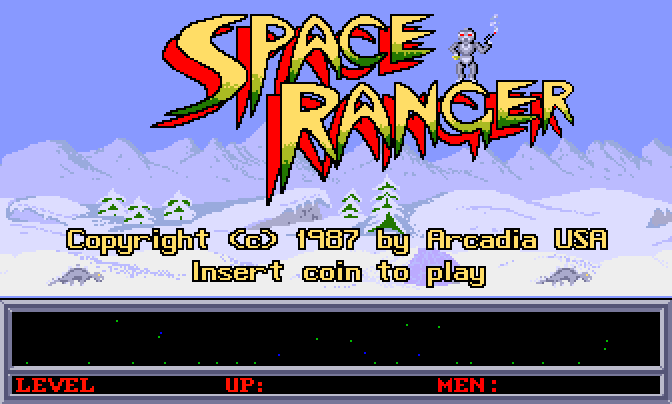
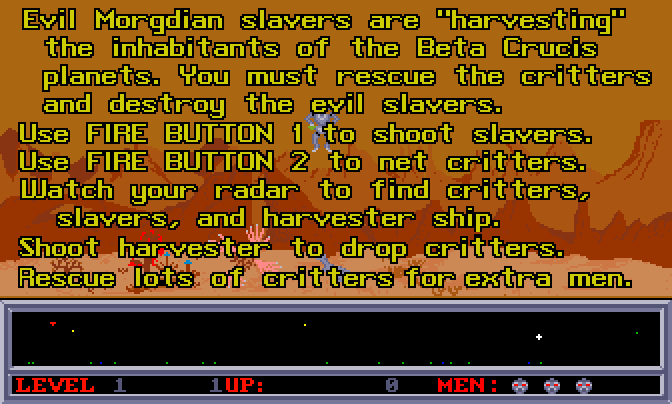
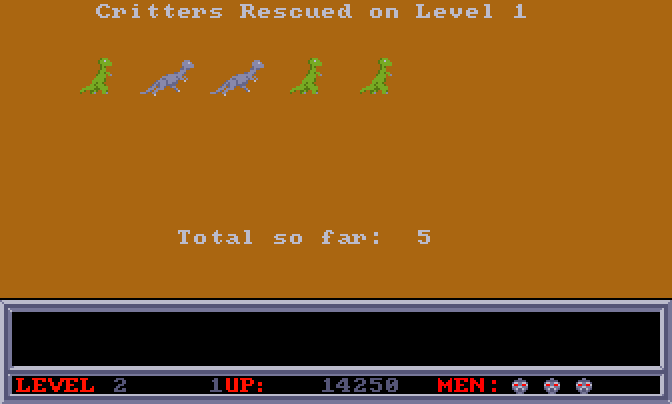
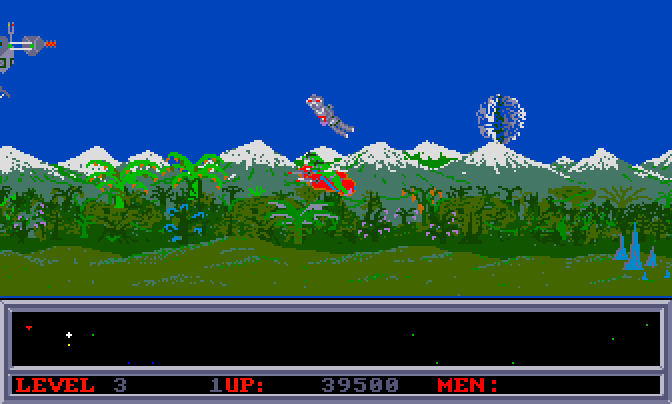
Semi-quadruplet
Semicom is one my favourite Korean developers and they were one of the more prolific Korean developers with multiple internal teams producing a large number of original games. While the majority are rough around the edges (and feel unfinished in places, for example the test modes are rarely complete / working) I’m always happy to see more turn up.
Su Ho Seong is the most obscure of the Semicom titles, it’s a gambling THEMED card game, I say themed because I don’t think it has any kind of pay-out or medal system, but rather is designed to be played for fun. Not much fun if you don’t know the rules, and the Korean language definitely presents a barrier there, but as the rarest and least documented of the SemiCom titles discovered in 2014 it’s good to have supported.
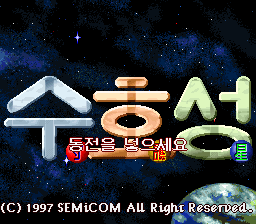
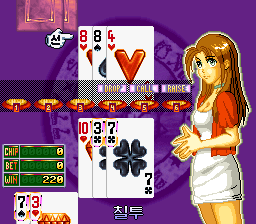
Carket Ball bridged the gap to playable status thanks to the correct protection data being added, this one also has a bar / cards theme to it but is primarily a pool game. Until it was discovered only low quality scans existed.
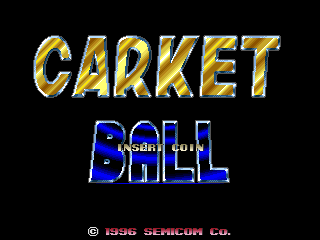
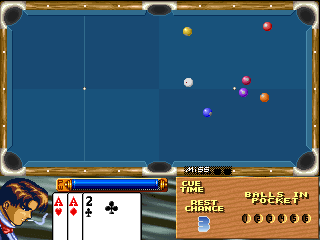
Cute Fighter was in the same boat, it had been considered an alt. version of SD Fighters until it was dumped, having it dumped and emulated showed it to be a sequel, not an alt version, not even on the same hardware. it runs on the newer 68020 based platform.
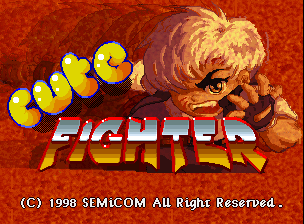
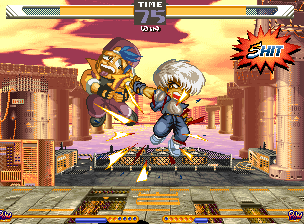
Rolling Crush turned up out of the blue too, a surprise finding running on Semicom’s 68020 based platform. This one doesn’t credit SemiCom anywhere other than the end credits, but clearly runs on SemiCom hardware, and the same base code as a number of other SemiCom titles.
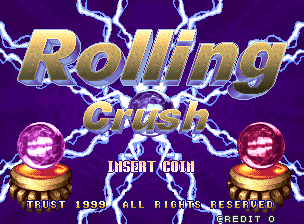
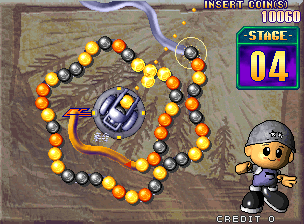
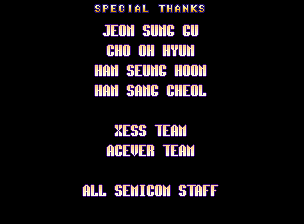
There was also another revision of Baryon (changes unknown) and also another set for the original Cookie and Bibi, unusually requiring different protection data than the existing one, I’m guessing it’s a newer revision because the test mode doesn’t crash the PCB like it did on the older set. I don’t know if there are any actual gameplay changes.
dgPix
dgPix were another of the Korean developers writing their own code – although almost bundled with an ‘adult photo viewer’ bonus feature, which is a shame, because of the two games found in 2014, Elfin and Jump Jump, Elfin would have made a decent Puzzle Bobble-with-a-twist style game without the content that is really only likely to drive away people who might have otherwise wanted to play it.
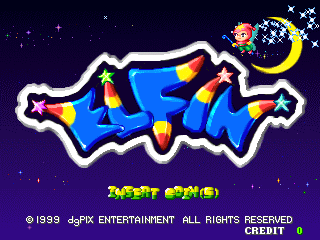
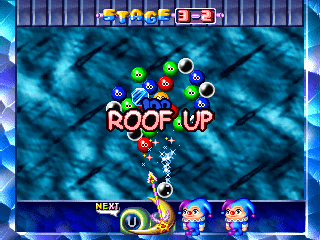
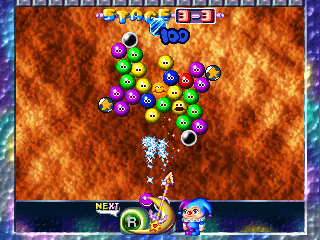
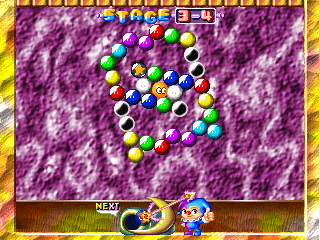
Jump Jump, possibly one of the worst named games in history due to the lack of a Jump feature for 99% of the game, is less fun, it’s far, far too easy to die, and the requirement for reaching the last stage involves collecting flags, flags that if you’ve already fallen past you have no way to get back up and collect.
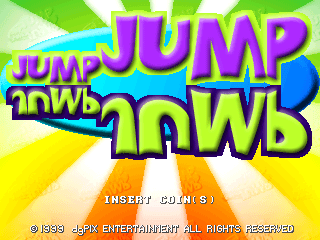
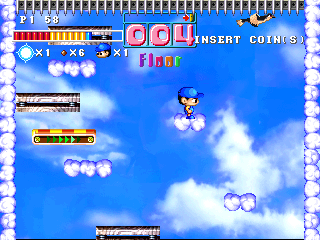
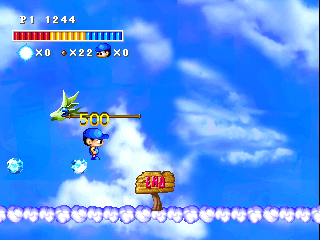
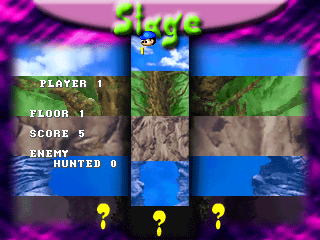
Comad
Undumped Comad titles used to show up frequently, in more recent times it’s been more of a trickle. Super Duck was added in 2014, strangely the only flyers we have for the game call it Hell Out which fits the theme better; the tiles for that title are still present in the ROMs but unused.
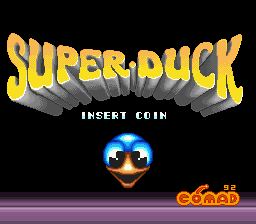
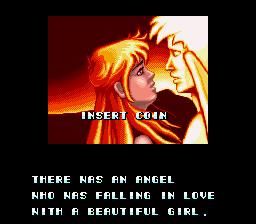
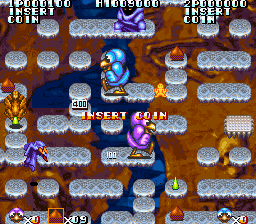
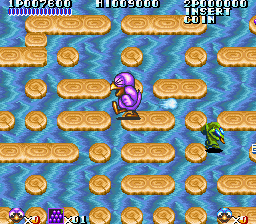
Actual Prototypes
When a Yukiwo PCB turned up it provided a fascinating insight into the development process of Taito’s Master of Weapon, showing that the game had even stronger thematic ties to the Akira franchise than were evident in the final released game. The prototype is noteworthy for it’s excessively long texts between stages, these were significantly refined with some bits moved to the attract sequence and others cut completely in the final game.

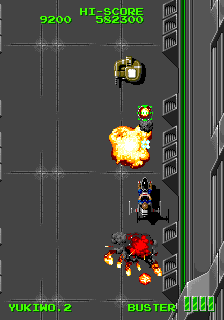
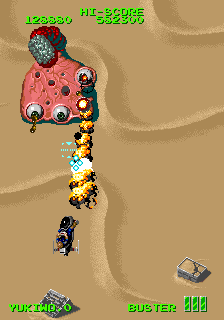
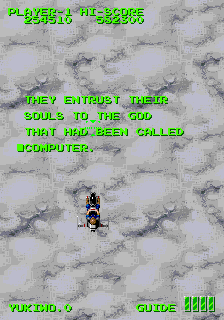
X2222 is another prototype that turned up in 2014, or more specifically, was given to us by one of the developers. In the end we ended up with 2 builds of the game, an early 5 level prototype with some mismatched graphics roms, and a later complete version but with debug information enabled and on-screen at all times. Unfortunately neither had any sound roms so they remain silent. Some sources still indicate the game was actually released in a limited capacity, but sometimes location tests are confused with a limited release, so it remains to be seen if anything more complete will ever turn up.
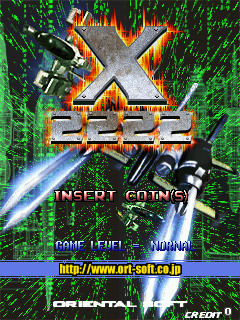
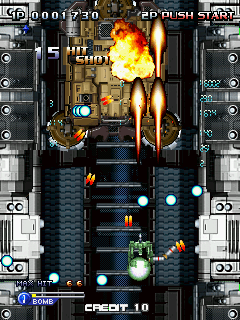
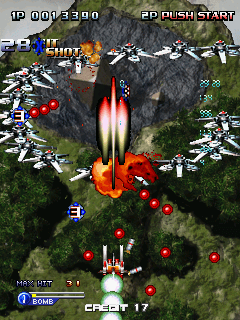
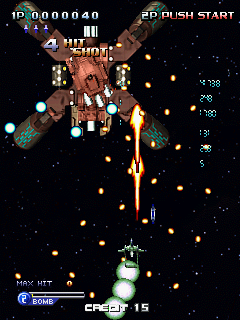

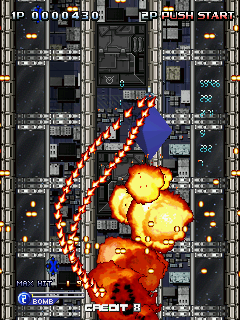
Possibly one of the more interesting things about the X2222 prototype was a revelation by the programmer that some of the names in the credits roll were intended as insults / a form of protest against the companies they were working with. Neither “Trok Cuf” nor “Tamorp Tihs” you see in the 2nd screenshot below are real names, instead they’re “Fuck ORT” and “Shit Promat” reversed.
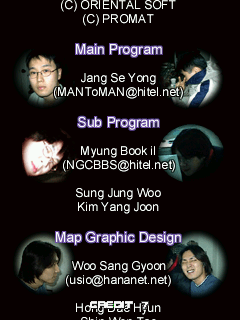
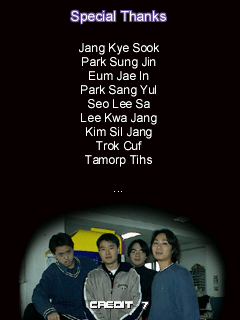
Hammer Away is the prototype that got the most attention tho, a seemingly 99% complete Sega game running on the System 18 board that ended up not being released after appearing at a number of trade shows.
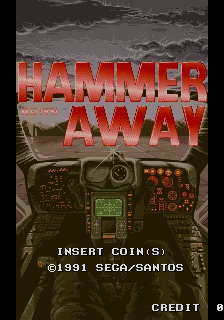
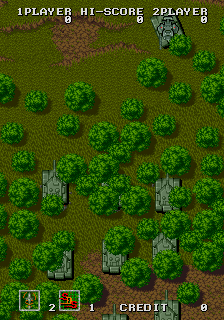
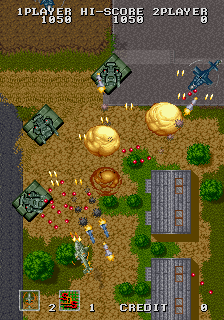
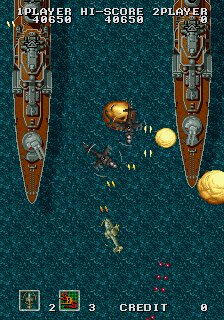
Center Court was also finally confirmed as a prototype / location test version of Passing Shot.
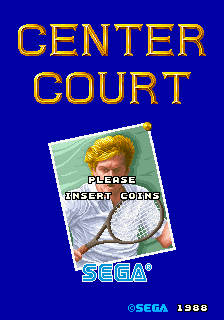
Original takes on Classic Games
Classic games are often imitated, and sometimes rather than creating an outright bootleg of a popular title a new game would be created instead, just one heavily influenced by the original.
Coco Loco is a Spanish take on Pacman. The game doesn’t use any assets at all from the original Pacman game but you can see that every aspect of the title is influenced by the original Pacman and the various Pacman hacks that were available.
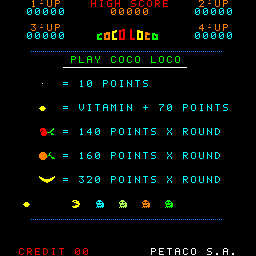
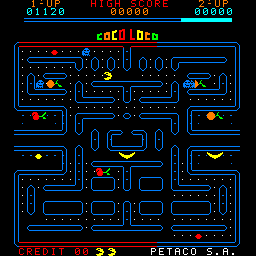
Alien Invaders is another, this game came in a tiny cabinet and sports one of the lowest resolutions of any arcade title we’ve emulated. The game is clearly influenced by the classic Space Invaders, but again is a completely original codebase with completely original assets.
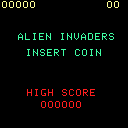
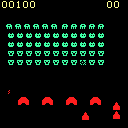
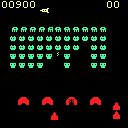
The ‘stealth’ games used to hide gambling games also often draw from well known classics and two of the most significant ones found during the year were ‘Super Pacman’ and ‘Tetris’ both of which exist only to hide a copy of Cherry Master underneath. These are terrible, terrible games but again show the influence titles like Pacman had.
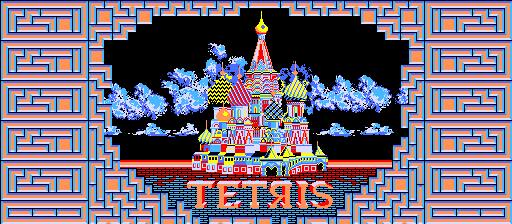
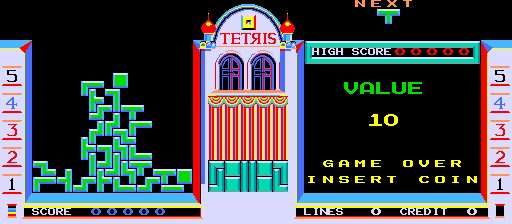
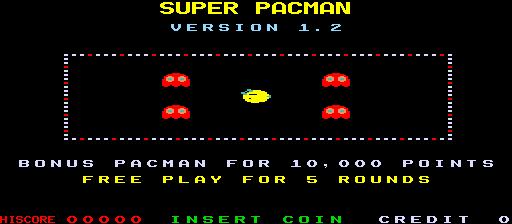
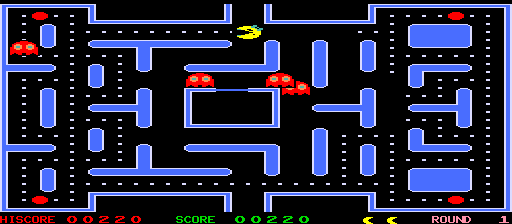
(These are incredibly poor versions of Pacman and Tetris… why do they exist – see below)
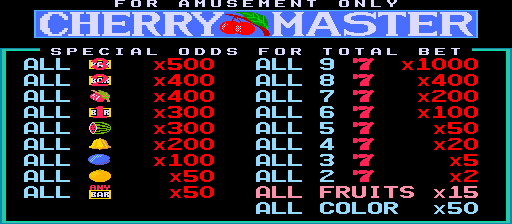

(.. because they’re just hiding a copy of Cherry Master from law enforcement)
Interesting bootlegs
Some of the more interesting bootlegs are cases where a game wasn’t even originally an arcade game at all. Gundam Wing Endless Duel is one such example. The game was actually released for the SNES, but existed in the arcades in bootleg form, hacked to use credits and operate like a conventional arcade game. These SNES based bootlegs are quite tricky to emulate because they typically have various protections and encryptions not present on the original games.
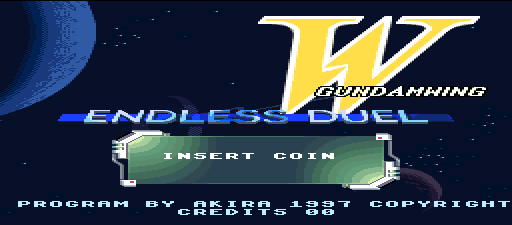

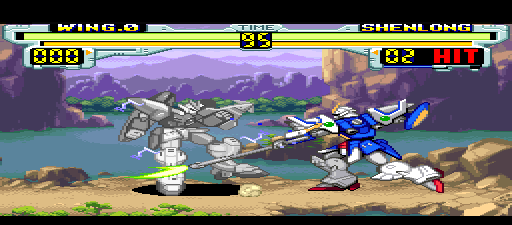
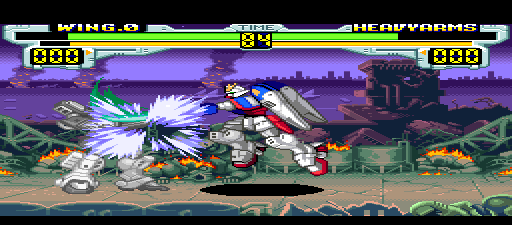
The Slightly Less Rare
The problem is we’re at a stage where everything is quite rare making it difficult to know how to classify things. Is Konami’s Step Champ a really rare game, or just one that hadn’t fallen into our hands until 2014, it’s hard to really know!
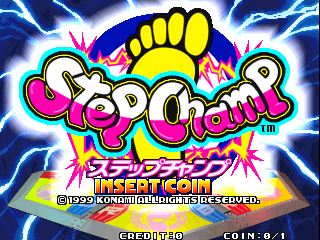
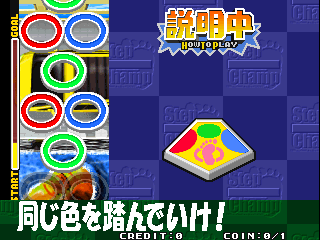
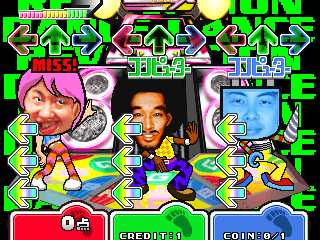
Top Blade V I can say with a little more certainty is easy enough to pick up, and had actually been dumped long ago, the only real hold-up was the protection which was figured out in 2014.
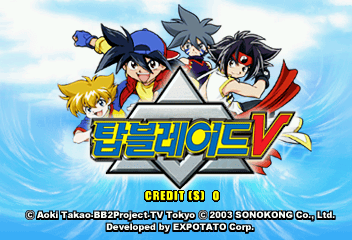
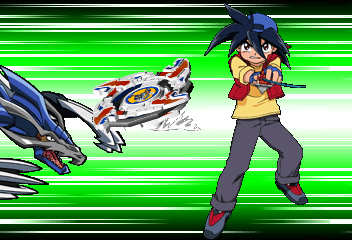
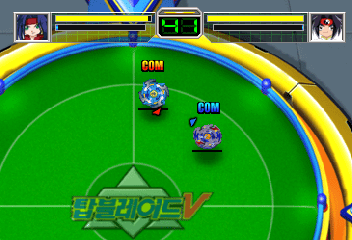
2014 caught the tail-end of some PGM work that was done in 2013, specifically protection data being extracted for Happy 6 and the cartridge version of Spectral vs. Generation. The Spectral vs. Generation cartridge does actually seem a bit less common than the PCB surprisingly, and unlike the PCB it actually feels more like a finished game (the changes are so significant it’s actually marked as version 2 rather than a revision of version 1)

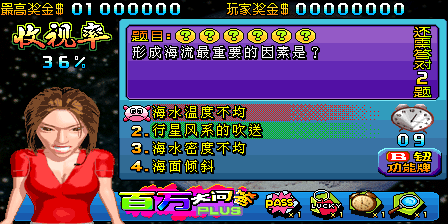
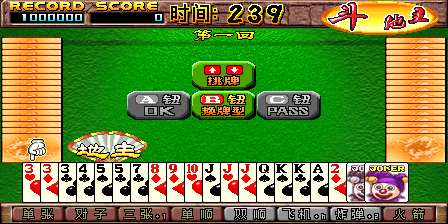
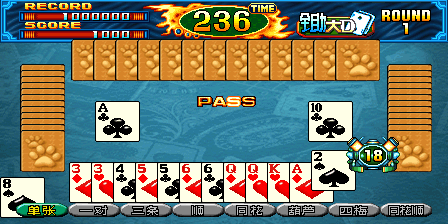
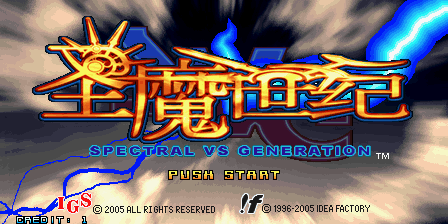
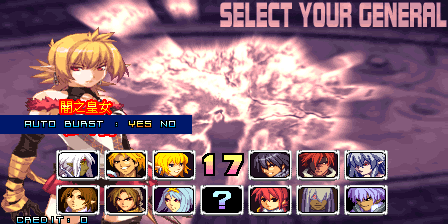
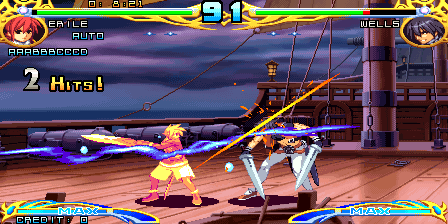
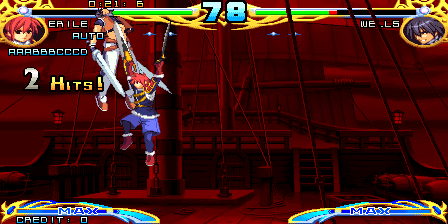
Research Needed..
Quite often it’s the case that an alt. version of something shows up and we don’t really know what the differences are.
A Bonze Adventure prototype was dumped, but it appears to be very similar to the final build at first glance, it even has all the protection inplace (unfortunately, because if the c-chip actually differs then it’ll never be dumped)
Home Systems
When prototypes are added to the MESS Software Lists they don’t usually get a great deal of attention – we don’t have a section of the whatnew file dedicated to listing new additions to Software Lists (I think for the more mature lists we should have) which means that unless you’re following other news sites you can easily be unaware of the significance of some of the discoveries made outside of the Arcade scene. Here I’m going to look at some of the highlights from that area.
Bill’s Tomato Game on the Genesis is an unreleased port of the immensely popular Amiga game. The prototype that turned up seems to be mostly complete, and a fully playable game, it’s interesting to see how it was adapted for play on a console instead of the Amiga, with a large number of simplifications taking place. Maybe that’s why it ultimately wasn’t released, a lot of the fiendish aspects of the original appear to be gone. As a big fan of the original I was really pleased to see this turn up, although I’m not sure why it was added to the Software List as ‘Bills Tomato Adventure’ rather than ‘Bills Tomato Game’
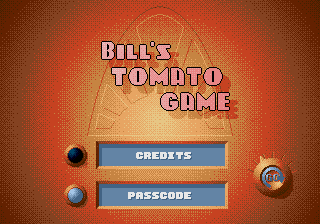
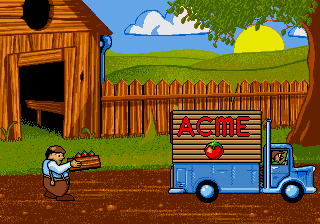
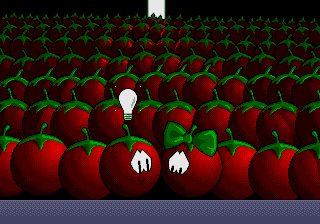
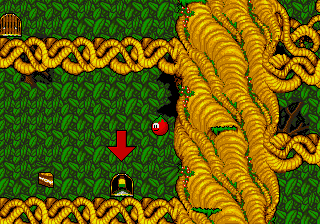
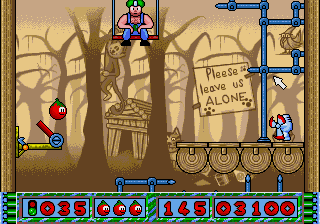

I said *some* highlights, so I should probably add some more, sifting through the softlist additions is time consuming tho because we don’t mention specific additions like this in our whatsnew files (that’s something I’d really like to change)
Functionality Improvements
NeoGeo MVS
Sometimes drivers gain new functionality due to core improvements, or taking advantage of newer core features that were introduced after the driver was originally created. One example of this can be seen with the NeoGeo MVS emulation.
The multi-cart aspect of the NeoGeo MVS is something that had been missing for a long time from MAME. As a hardware feature it was perhaps one of the most important aspects of the NeoGeo in it’s early life, allowing operators to give the player a choice of games in a single cabinet, and by mixing a number of genres allowing each cabinet to appeal to a wider audience. While the feature slipped down in terms of importance as the individual games got bigger and flashier it certainly helped SNK establish a foothold on the market.
By making use of the Slot devices and SOftware Lists MAME is now able to emulate an MVS system with more than one game plugged in.
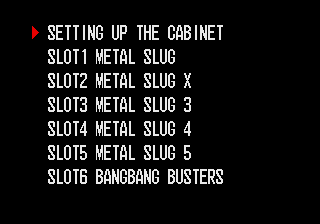
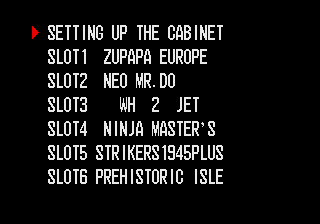
Lua
Other times functionality improvements are more subtle, opening potential for later use, the lua scripts are a good example of this as they provide a powerful way of controlling MAME, and for MAME to potentially control other things.
The Lua scripting saw some heavy changes over the course of the year, with external contributions helping beef up the capabilities to allow, for example, reading the memory of the emulated system. Improvements this could allow some complex scripts to be developed that react to the running state of a machine.
Ease of Development
One of the big factors that has kept MAME alive over the years is the constant improvements made that make life easier for developers, a factor that is often overlooked when people complain about MAME getting slower etc. MAME today is a far better organized project than it was in the past and utilizes a proper objected orientated ‘device’ system, where every emulated piece of hardware system is a collection of devices running in an emulated timespace.
The debugger is also an essential part of the MAME development process, we actually have two, one used for regular Windows builds and a QT based one used in SDL based builds (Windows and other platforms) Amongst the tweaks made over the year the QT debugger gained the ability to view the device hierarchy (you can also click on the entries to open a window containing further details) This is potentially an important step to allow more precise debugging of the internal state of devices.
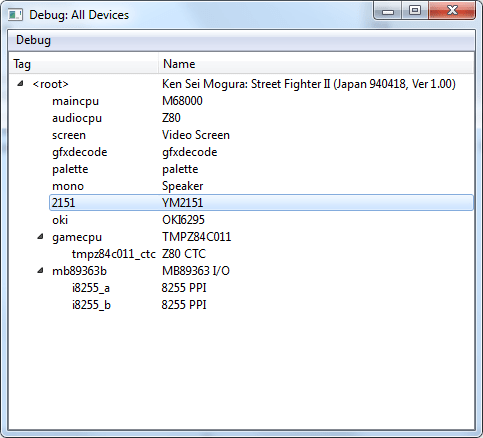
One of the big plans for the future is to actually make it so that the root device is a place where more than one machine can exist, effectively allowing us to run multiple different machines (arcade or console/computer) at the same time. It’s actually not far off possible now, but requires a good plan to move forward.
Dumping the Undumpable
Sometimes the real hold-up when it comes to the emulation of a system is the lack of dumps, while the most common reason for this is simply that a PCB has not yet been secured, there can be other reasons too, the main one being that the ROM data is either stored in a protected MCU, or non-standard type ROM packages.
For MCUs the typical process for dumping is to either find an exploit that can allow the internal code to be read out (or in some cases, use known existing ones) or decap the chip (assuming it’s a MASK part inside) For custom rom packages it’s often a case of tracing lines on the PCB to try and work out what the package is equivalent to, and finding out if it can be dumped with a lot of wire mods.
Unfortunately the original MAME decapping project died a death a few years ago (before it had really even started) leaving others to pick up some of the pieces and leaving certain chips that we previously thought might be possible completely out of reach (Taito C-Chips, Toaplan sound CPUs etc.) but nevertheless we did see some important decaps and other noteworthy cases of the undumpable being dumped leading to progress especially in the MESS part of the project.
NMK004 – Sound for a generation
One case where we saw the internal ROM of a chip dumped through finding code exploits was the NMK004. Previously the sound and music in a large number of NMK games was handled with simulation code – manually processing the data sequences in the external audio rom, and attempting to play back the music and sound effects without knowing full details of the data formats. Having a real dump of the internal ROM allowed this simulation code to be removed, and replaced by actual accurate emulation.
The biggest beneficiary of this was USSAF Mustang, which, for some reason did not work at all with the simulation code; in old versions of MAME the only way to play this game with sound was by using a bootleg, but even the bootleg didn’t have proper sounds, it used a sound program stolen from Seibu’s popular game Raiden, and thus the soundtrack didn’t really fit the game.
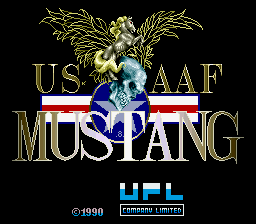
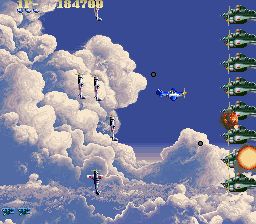
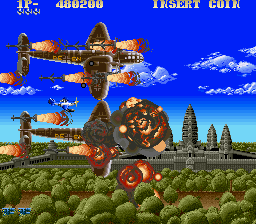
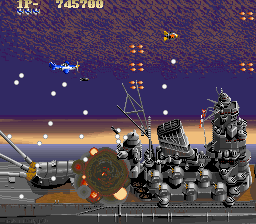
Strahl also benefitted hugely, although only after it was realised that some lines must have been swapped on the sample roms, as the banking is inverted compared to the other NMK004 games. Other games to benefit from this were Bio-ship Paladin (Space Battle Ship Gomorrah), Vandyke, Black Heart, Acrobat Mission, Thunder Dragon, Super Spacefortress Macross and GunNail. Proper sound emulation in these is like having them freshly emulated all over again, it really breathes new life into the games.
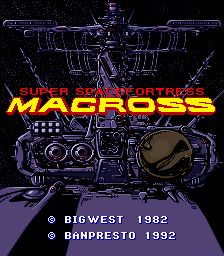
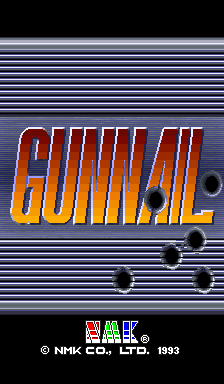
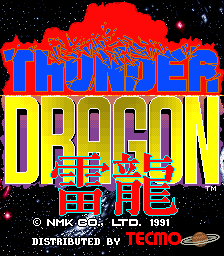
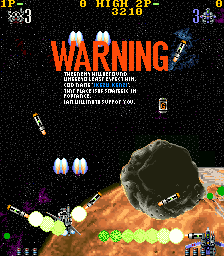
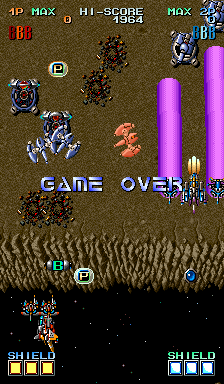
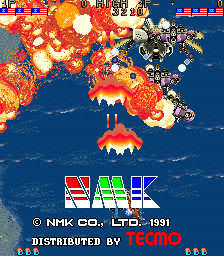
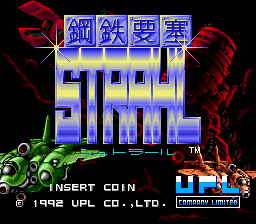
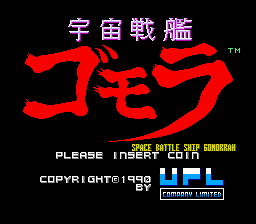
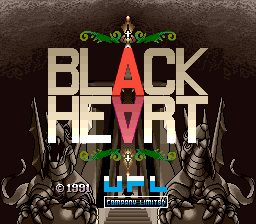
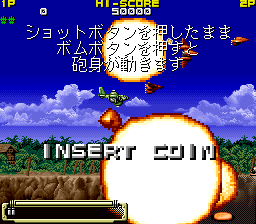
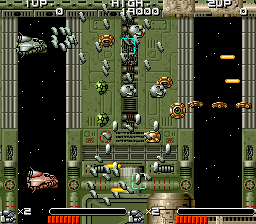
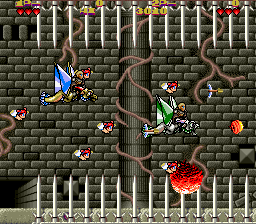
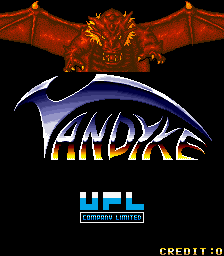
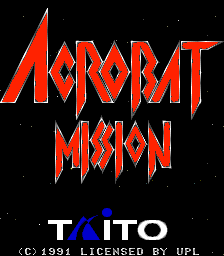
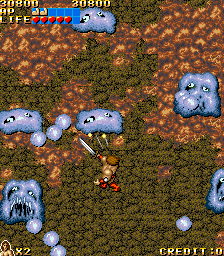
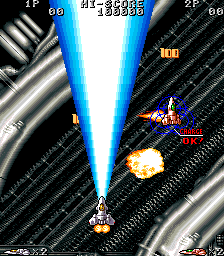
There’s one more I haven’t mentioned yet, Hacha Mecha Fighter. At the same time as the NMK004 internal ROM was dumped a bootleg version of Hacha Mecha Fighter was also dumped, I say bootleg, it was actually a conversion of a Thunder Dragon board with the HMF protection removed so it features full sound and music provided by the newly emulated NMK004. It’s one of NMK’s zanier shooters, and while content does end up heavily recycled throughout the game it’s well worth checking out. The protection emulation on the original game (which was wrongly marked as ‘Working’ for many years was also improved based on this bootleg, although the protection sets now lack sound – they don’t do the correct handshake with the NMK004, and it looks quite likely that the protection MCU talks to the NMK004 directly, plucking commands from RAM)
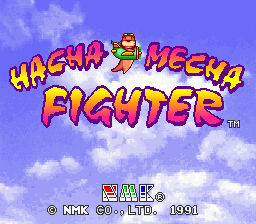
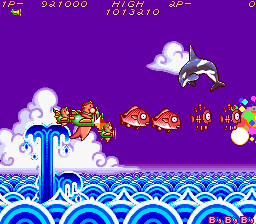
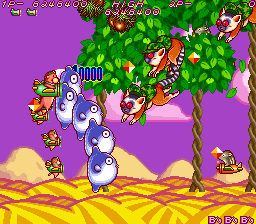
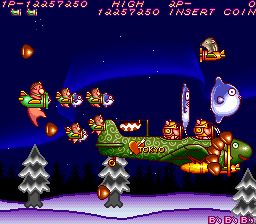
My Mate
The Gamate is an example of where the ROM data was stored in non-standard packages, epoxy blobs on the game cartridges and system to be precise, meaning that both the game data, and cartridge data could not be dumped using the conventional method of removing chips and placing them in an eeprom programmer to read them.
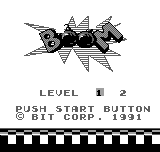

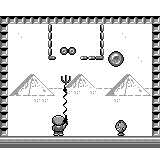
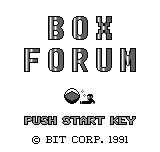
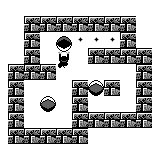
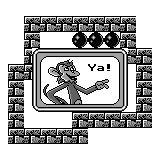
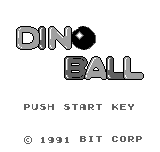
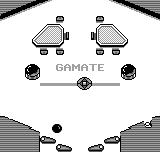

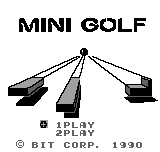
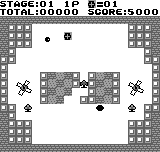
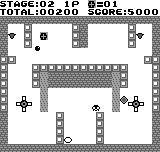
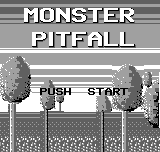
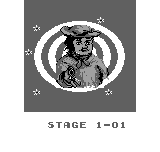
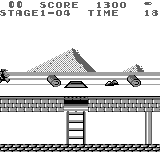
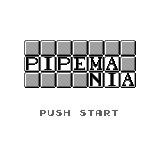

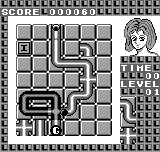
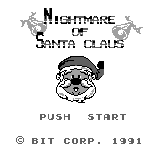

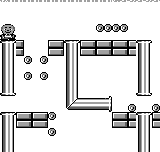
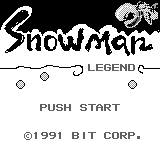
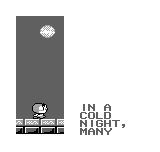

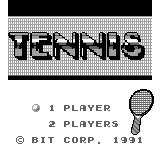
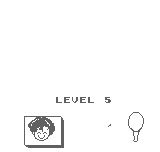
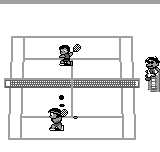
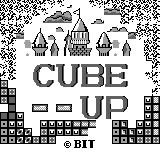

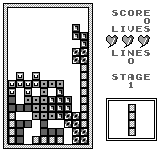
Some games were released with different titles, for example Mighty Tank is the same game as Vindicators (the gameplay is based on Namco’s Tank Battalion / Tank Force) and Enchanced Bricks appears to be the same game as Brick Blast (although it isn’t playable, it thinks you’ve cleared the levels before you’ve even started)
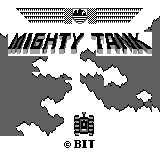
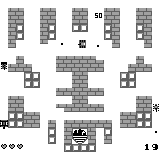
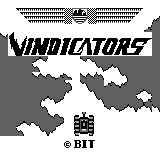
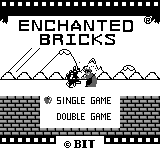
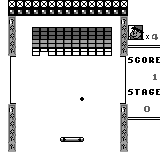
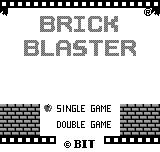
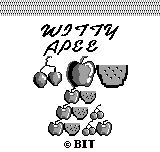
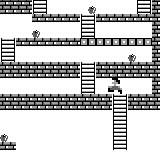
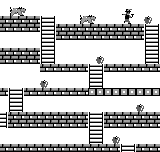
Games with vertical scrolling, such as Tornado (a vertical shmup) are more problematic, and glitch to the point of being unplayable when the screen scrolls. Marauder, another shmup suffers from the same issue, as does Kill Shot, which is actually based on the design of Konami’s Block Hole!
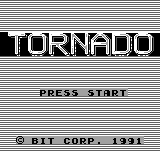
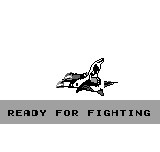
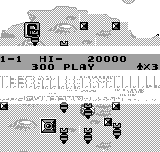

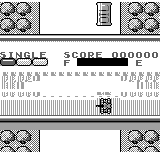

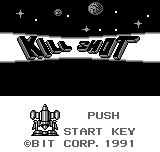
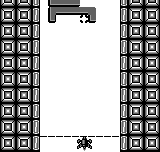
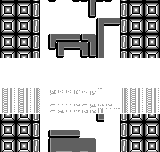
Other titles still seem to have logic bugs, for example in Pharaoh’s Revenger it seems to be impossible to climb the rope.
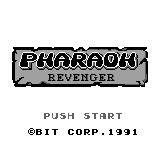
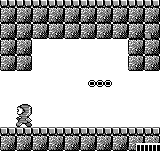
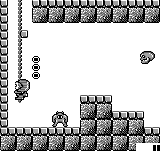
and in Money Maze the collisions seem broken and you end up blocking off your own paths when you move, meaning you can only ever move horizontally.
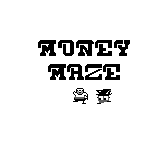
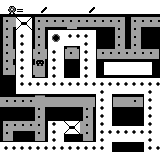
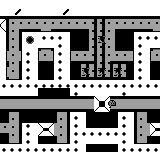
Flip is based on Taito’s Plotting, aka Flipull but it freezes after your first move
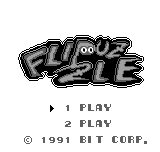

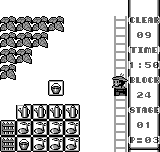
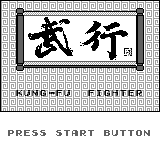
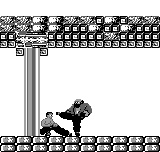
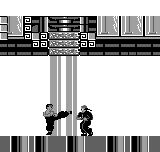
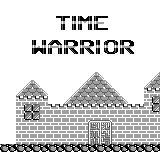
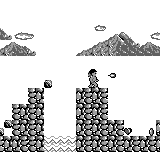
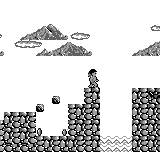
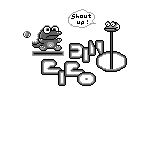
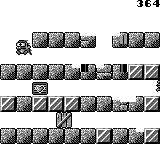
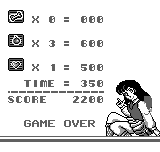
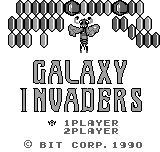
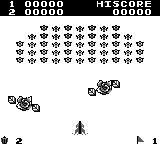

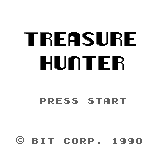
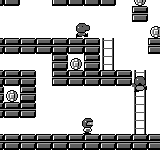
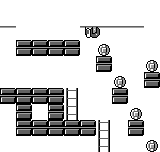
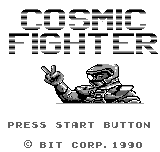
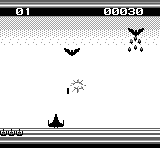
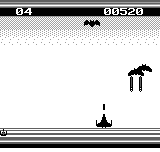
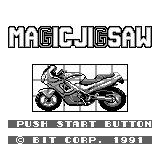
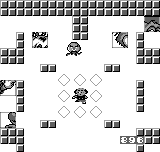
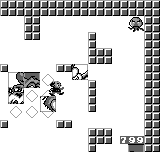
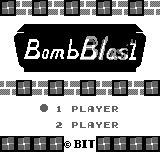
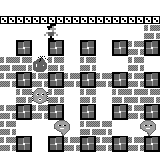
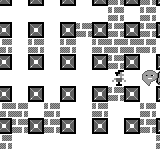
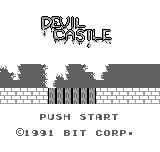
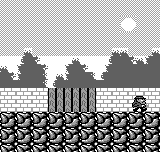
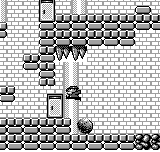
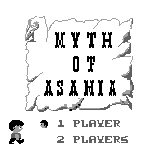
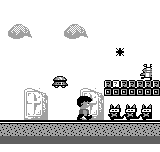
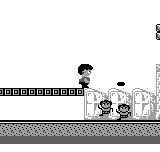
As I’m quite late in publishing this article (it represents the progress at the end of 2014) I recommend you actually give this driver a spin yourself, a lot of the issues that were present at the time of writing have since been fixed, something that will be covered in the 2015 article.
Electronic Toys
One movement that started to gain some momentum in 2014 was the one towards emulating a number of electronic toys. Many of these due to their tiny size and relative simplicity were designed around MCUs containing internal ROMs which meant getting dumps of them was a challenge. They’re also in most cases non-video devices and non-video stuff has only been seen as a viable emulation target in more recent years.
The Tandy 12 is one such electronic toy, it offers a number of game modes, although without a manual it can be tricky to figure out.
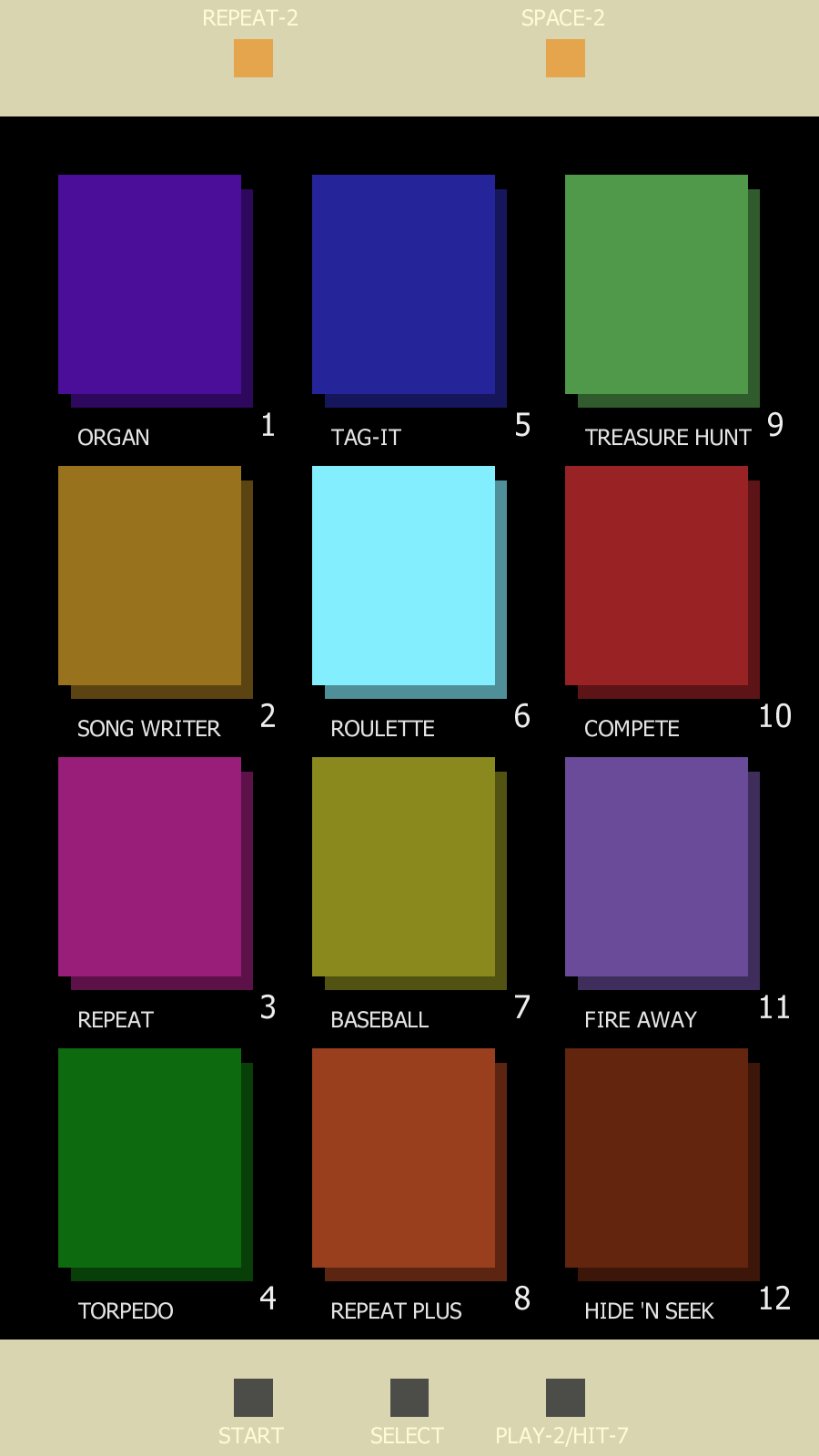

There were a number of others too, this is one area I need to improve for this article especially as this work grew into something even more significant in 2015.
Emulating the ‘unemulatable’
For a long time the non-CPU games were considered impossible to emulate, the boards contained no CPUs therefore contained no code, and therefore there was nothing for your emulator to run. Thinking in recent years changed that, things started getting emulated on a circuit-level. 2014 saw MAME step things up a little with the emulation of these ‘discrete’ titles and while DICE is still the primary choice for emulation of non-CPU games there were countless improvements to the discrete system in MAME over the course of the year with significant work done in all areas of the code.
The main visible result of all this is Pong Doubles now being playable. Pong doubles, as the name suggests, is a doubled up version of Pong with 4 bats.
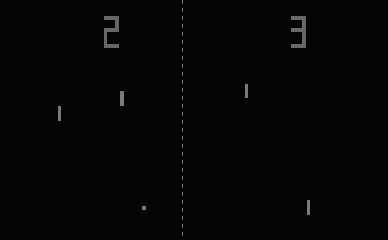
The discrete system was also improved so that sound emulation can be done with the same modern code that is being used to emulate entire discrete games, the filters in 1942 for example were converted over to the new system giving better sound.
Discrete Romsets
While all the discrete games lack a CPU by definition not all of them lacked roms, as a matter of fact, many made use of roms for graphical data and look-up tables just like any other game. Before 2014 those romsets had nowhere to really go, and owners of these rare boards, which often made use of uncommon early types of ROM devices, had no idea if backup images were available for their PCBs in the event of failure. It was good news therefore when in 2014 we decided to add skeleton drivers for all the ‘TTL’ games for which we have ROM dumps. Not much has been done with them yet (in theory you could decode the graphics and allow the F4 viewer to show them) but they’re documented and in the source ready for when somebody feels (very) ambitious with the discrete system.
Audio Progress
The most significant progress made with sound emulation has already been mentioned, it was, in my opinion, the NMK004 work, however, that’s not the only progress made in 2014 when it comes to the Audio side of the titles we emulate.
For a number of Playstation based platforms Taito use an unkind combination of a MN1020012A CPU and ZSG-2 Audio chip for the music. The CPU wasn’t fully emulated, and the Audio chip completely undocumented. Had the situation been reversed (undocumented CPU) then it would have been worse, but thankfully that was not the case, and we saw improvements in 2014 to give preliminary music to the G-Net titles, and FX-1B titles using this combination of chips. The sound is still a bit tinny, possibly due to bad sample format decoding, or the missing DSP, but something is a lot better than nothing. Games to benefit include G-Darius, Super Puzzle Bobble, Psyvariar, XII Stag and plenty of others; much like the NMK work this covers the audio in a lot of ‘shmup’ games. A word of caution however, the performance requirements have shot up accordingly.
Missing Hookups
Sometimes getting audio to work in a driver is simply a case of adding in chips that were overlooked, or not properly identified when the drivers were initially added. This was the case for BMC titles ‘King of Football’ and ‘Konkyuu no Hoshi’ (BMC Bowling) where the YM2413 was not hooked up.
Taito’s Cycle Shooting (and the bootleg Bronx) were also missing some sounds due to a DAC being overlooked, it’s used for sample playback.
The two screen version of Jaleco’s Brand New Stars also had sound hooked up, it turned out to be basically the same as the Megasystem32 version.
Overlooked
Over the course of the year I’ve tried to highlight important / interesting progress within the project, but even then sometimes things get overlooked or forgotten because I wasn’t able to test them at the time they were added. One of the reasons I do these write ups is because I enjoy going through the changes and seeing if I missed anything.
One such thing I failed to cover the first time around was the addition of the original Konami Pop ‘n’ Music game, I actually feel rather bad for missing this one because getting these dumped and supported is very important, they’re old games using HDDs for storage, and I don’t think I need to say how unreliable HDDs are, especially not when we’re dealing with ones from the 1990s that have taken the daily abuse of an arcade environment in their lifetimes.
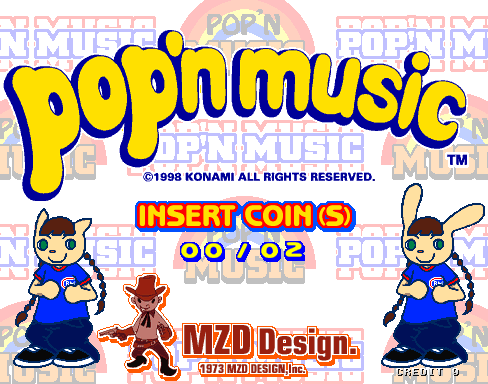
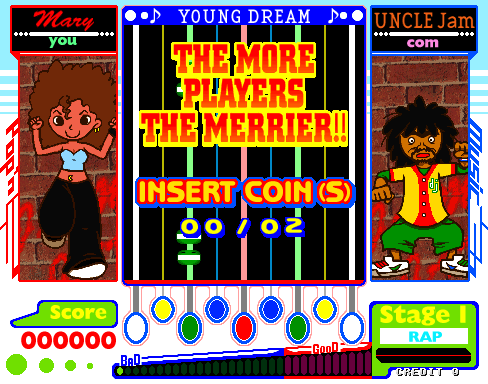
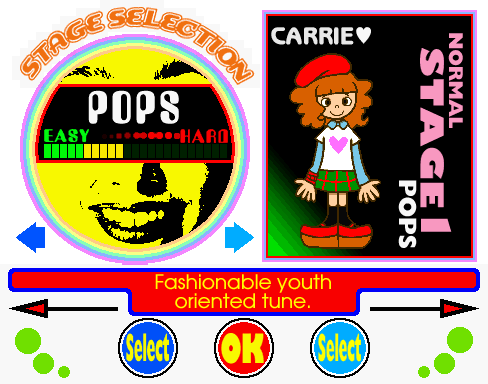
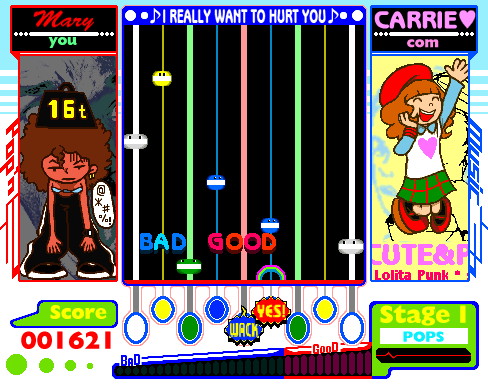
It’s also very easy to overlook games that are in certain genres, especially poker type games. Going through the yearly logs I noticed that there were actually 4 unique games from Merit added over the course of the year all running on their 2nd major hardware revision. The most interesting of these is the original Pit Boss Megatouch, previously the earliest emulated Mega Touch game was Mega Touch 2.
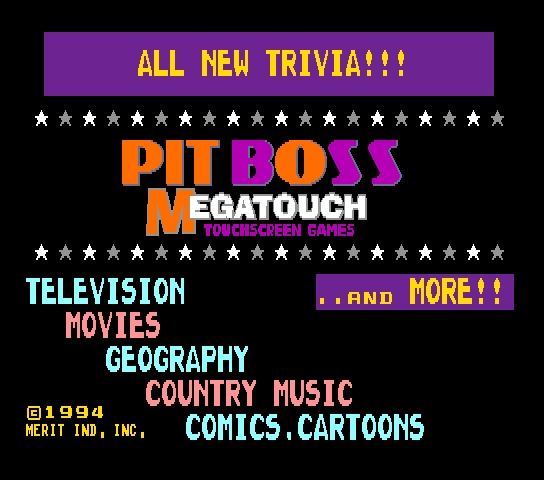
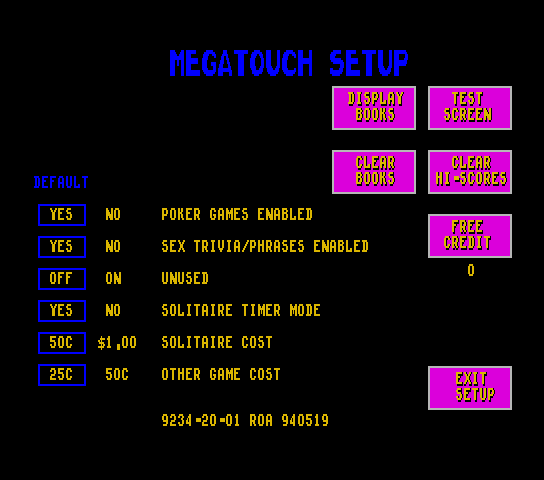

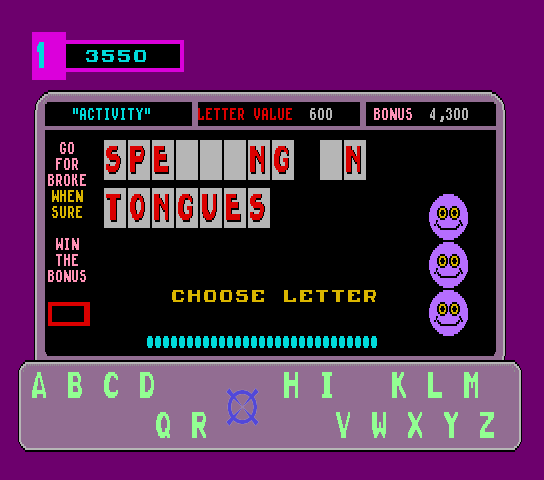

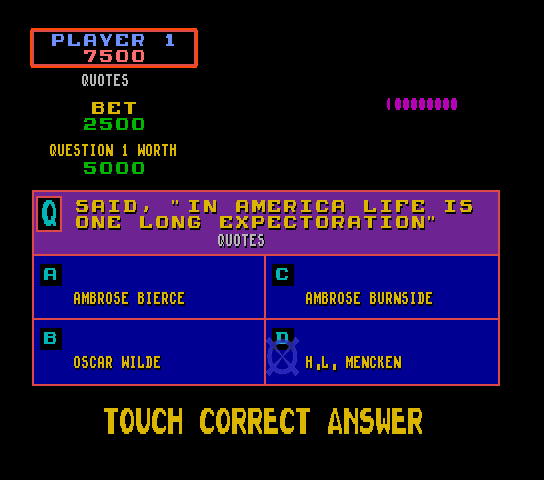
There was another Merit touchscreen game, this time an unnamed Joker Poker style game, I don’t know if it never had a title, has been hacked, or if the title was on the cabinet only, but we don’t actually know for certain what it is called so it was simply added as “Merit Touch Joker Poker (9132-00)”
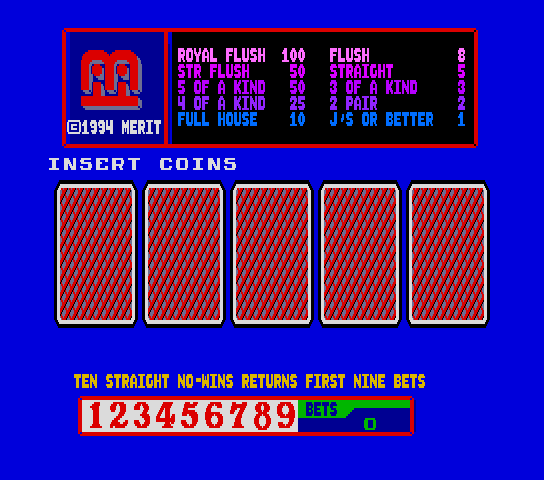
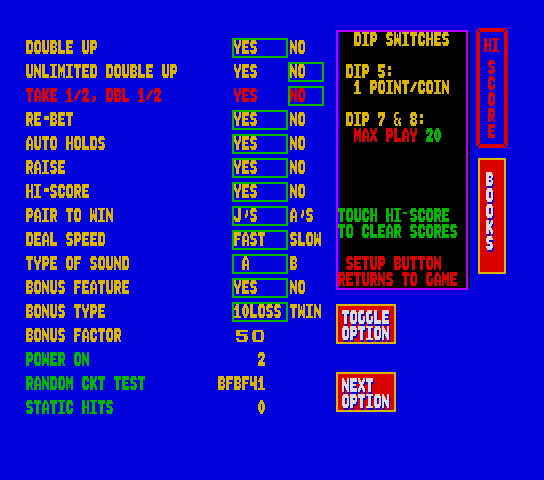

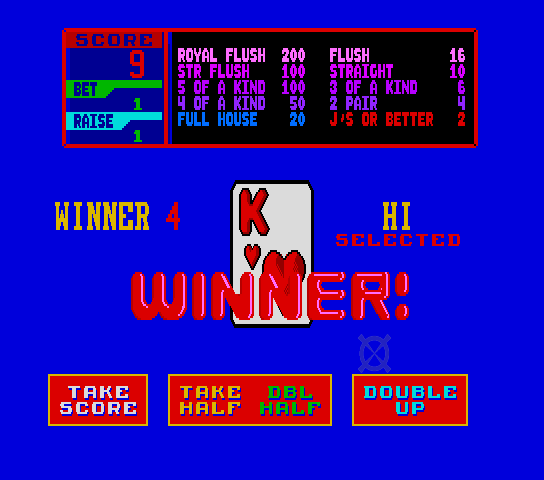
The other 2 Merit games are also Poker titles although this time neither of them are touch screen titles. Americana is the first of these, and presentation wise it actually looks very similar to the touchscreen game above, although this one does have a title and attract sequence. If the date is to be believed this is actually a good 7 years older than the above touchscreen variant too and the oldest supported set in the entire driver.
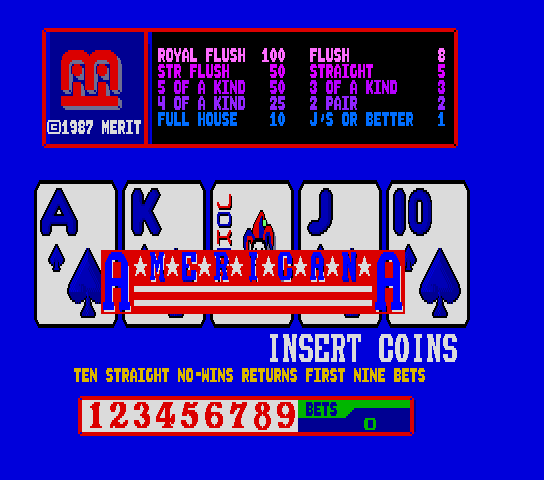

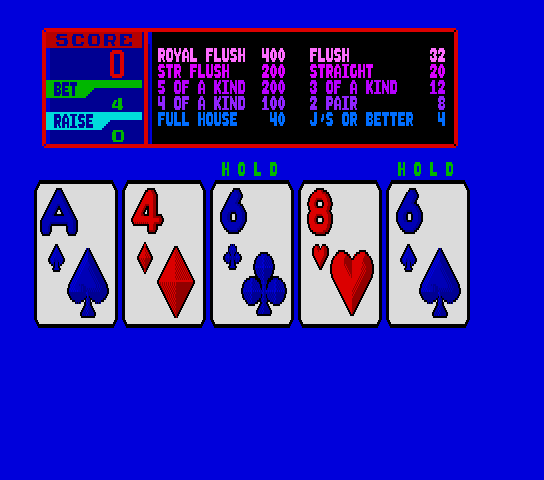

‘The Real Broadway’ is the other poker game, a very basic title, I don’t think it even has a Double Up feature, the presentation is quite different to the two above tho.
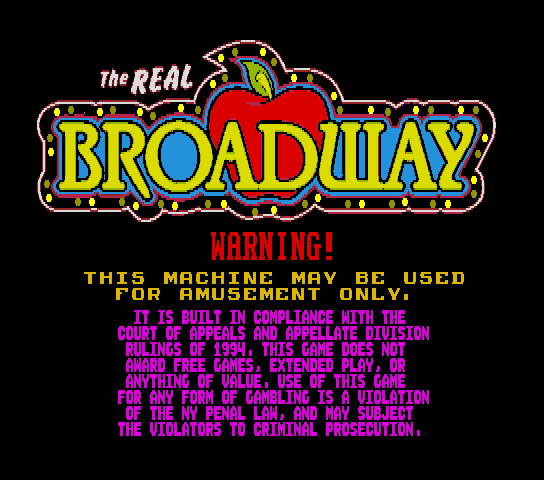

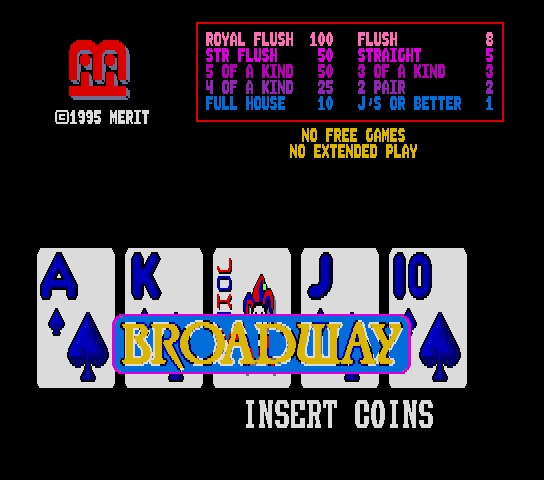
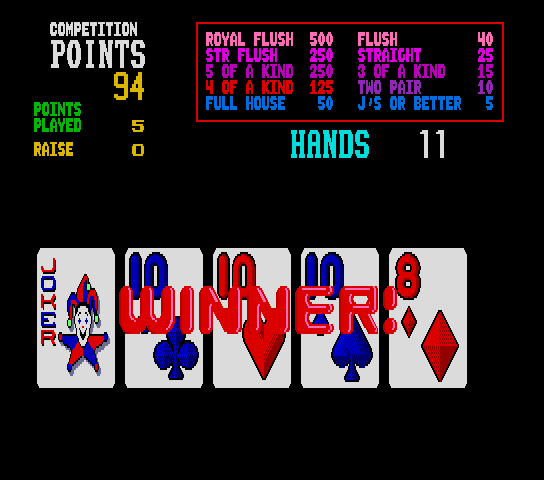
While I don’t think any of the Merit games are especially interesting on their own they’re important pieces of history because Merit continue to produce their touchscreen games to this day so seeing their early developments is a good history lesson.
The German games in ‘adp.c’ were also improved over the course of the year, although are still marked as NOT working. The driver contains both video based, and non-video games, with the video ones making use of a H63484 chip for the a blitter with support for many complex graphic operations including drawing circles, fills, patterns etc. The H63484 is where improvements were seen.
The games in the driver seem to follow a similar evolution as the Megatouch games, with early single game titles like Skat
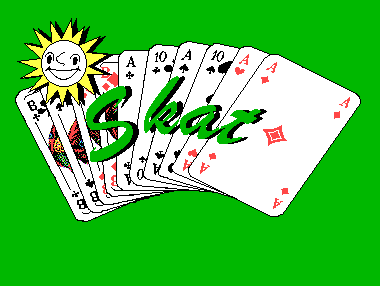
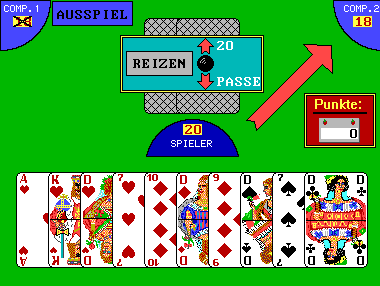
Later evolving into a 4-in-1 called Fashion Gambler
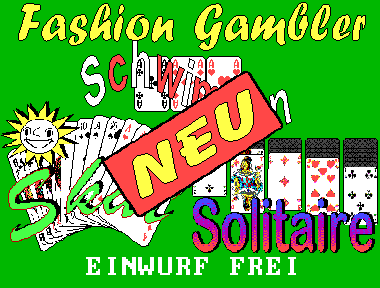
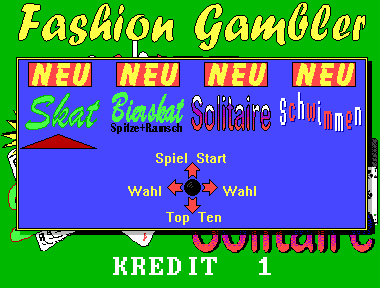
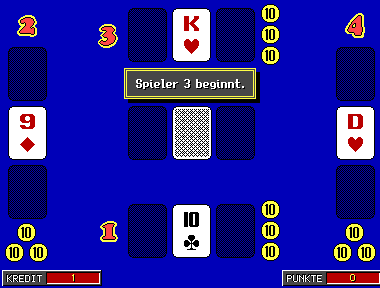
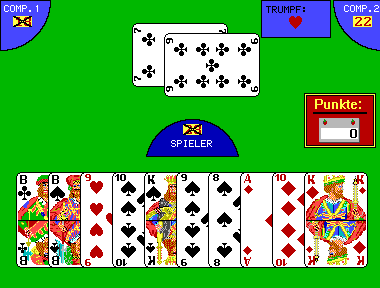
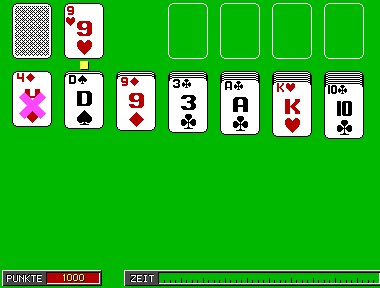
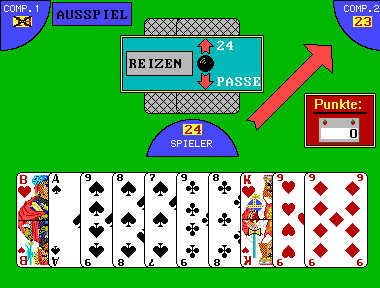
and then a later higher resolution title called ‘Fun Station’ with even more games, sadly the Tetris / Puyo Puyo clone still crashes the emulator at the moment, but the driver is still marked as not working so I shouldn’t be too surprised!
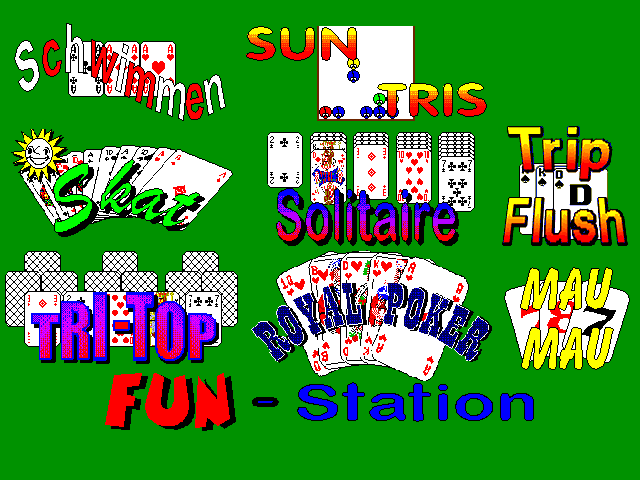

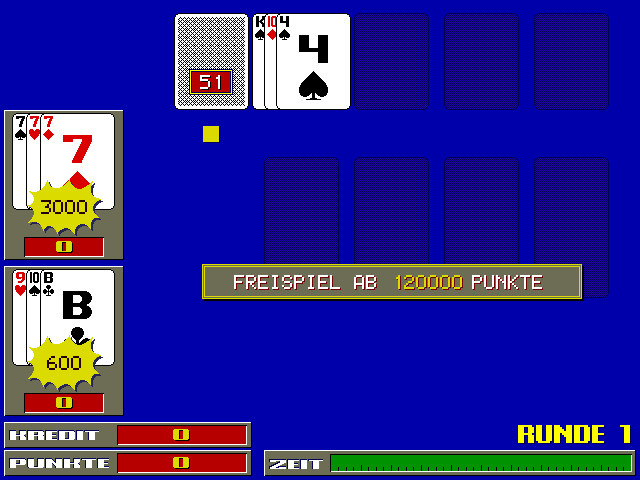
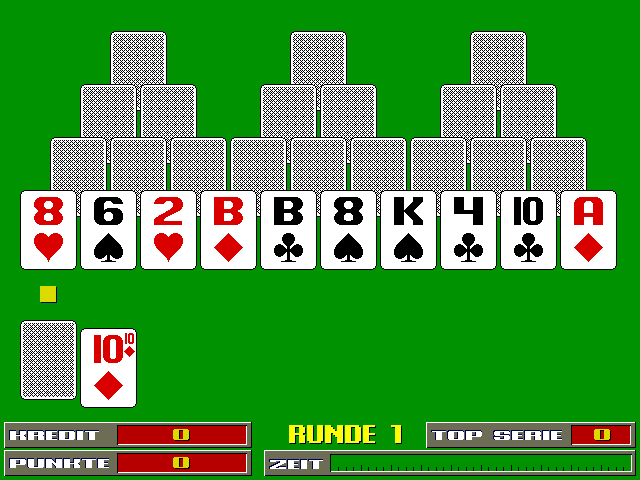
There were other games on the platform such as Quick Jack too
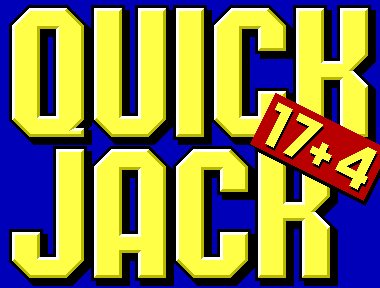

and ‘Funny Land de Luxe’ which may or may not be a proper game, or video part of something else, it does the least of all of them (except Backgammon which is non-video)
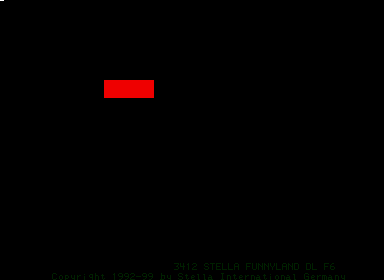
Guns & Roses is yet another gambling game, this one from Australia on Aristocrat’s MK4 hardware. Many of these are very, very rare now as the games were banned and destroyed. Unfortunately there are issues with the rom dump, missing the PROM at least giving bad colours. The init sequence on this one is quite tricky, like all the MK4 games, but is at least properly documented in the source.
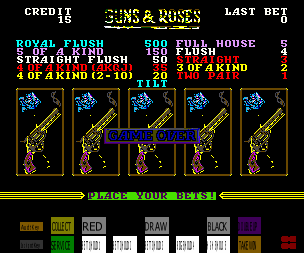

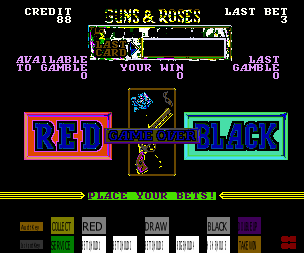
Grasping at Toys
Sega’s Ufo Catcher series of games represents one of the most famous brands of ‘Crane Machines’ found in arcades both old and new. Obviously over time the internals of the machines have evolved, the attract sequences have become more elaborate, and, like everything, the cost of ‘playing’ them has increased too. While emulating them is a little pointless from a gameplay point of view (there’s no physical container full of toys for a start) it is actually technically possible to simulate enough of the machine to keep the game code happy and for a number of older models that is exactly what was done in 2014. A number of themed versions of the ‘New Ufo Catcher’ machine / software were released, including Xmas and Sonic themed ones each with different music playing during the attract mode (the Sonic one plays the Marble Zone theme during attract and the ‘Invincible’ one when you start a game, slightly reworked versions, while the Xmas one plays Christmas songs, obviously)
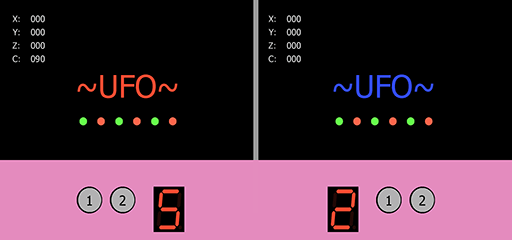
While the New UFO Catcher units all appear to be 2 player setups (or at least the dumped ones are) some of the older Ufo Catcher sets are designed for single player cabinets, but otherwise operate in a similar way, again with different music for each version.
Sega Clones
Shoutime’s work in tracking down Japanese clones wasn’t as well publicized this year as last, but upon reviewing the contributions made over the year you can see that he managed to locate a significant number of them, including previously undumped versions of a number of Sega titles.
4 such clones were games for Sega’s System32 / Multi32 platforms meaning that we now support authentic Japanese releases for F1 Exhaust Note, Air Rescue, and Spiderman; Title Fight is there too although still suffers from a long term video emulation regression.

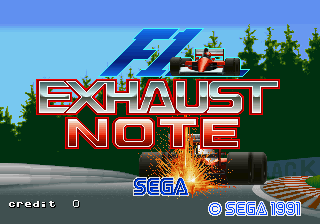
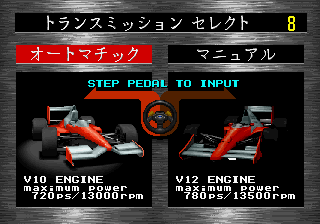
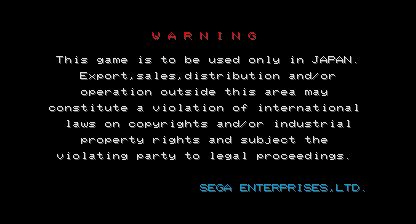
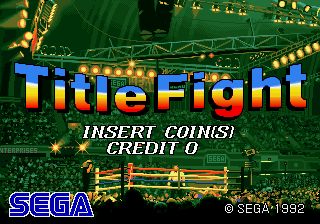
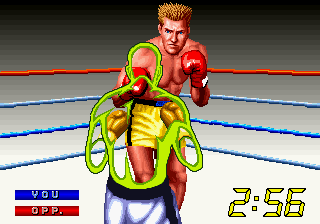
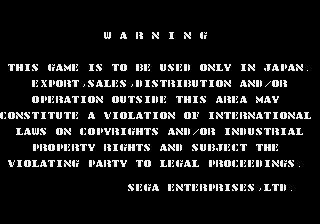
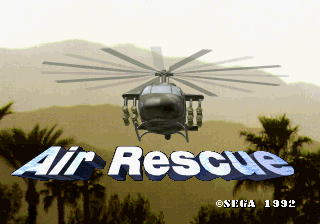
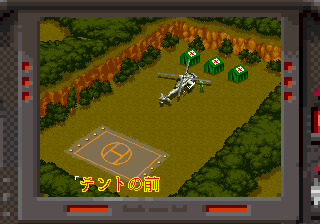
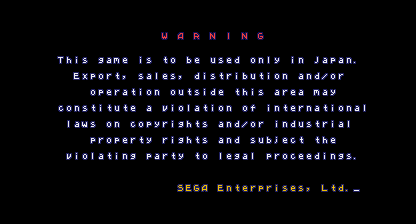
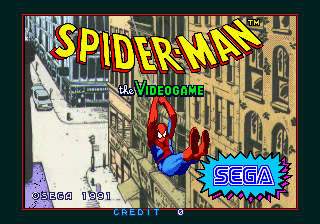
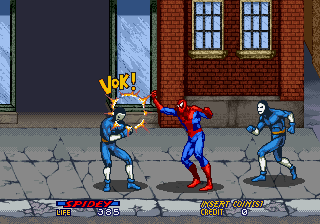
Rare Regions
Some regional releases of games were incredibly uncommon, locating them and adding support for them is an important part of documenting our history. One such crazy rare clone is Konami’s Crazy Cross. Previously we’d found an English language ‘Let’s Play Crazy Cross’ on Playstation based hardware, but it was looking increasingly likely that no official English version of the original game existed. Most copies of the game get sold as ‘Crazy Cross’ because it’s the title people are familiar with from the Playstation release, but in every prior case the actual product being sold has turned out to be ‘Taisen Puzzle-dama’ the common Japanese version of the game. When an actual Crazy Cross was found in 2014 we were delighted.
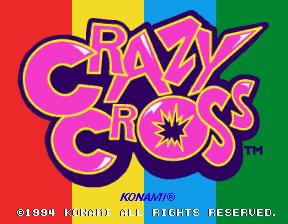
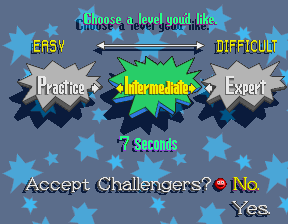
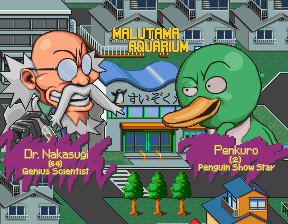
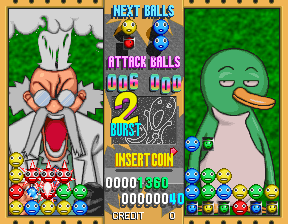
Another rare clone is Irem’s Air Assault, the world version of a game better known by it’s Japanese release title of Fire Barrel. The only known / documented copy of this game was the one that had been on location in London for many years, and ultimately that’s the copy that ended up being dumped.
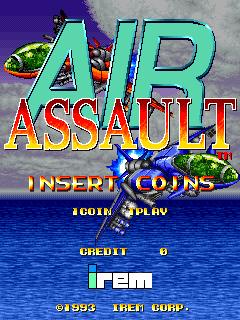
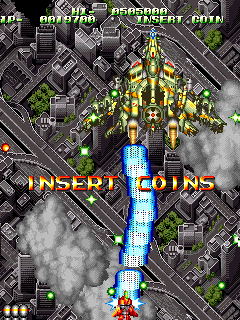
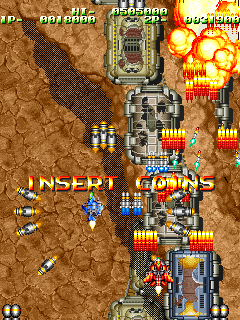
The later CAVE games aren’t really known for their international releases either, so it was a bit of a surprise when somebody ended up being shipped an ‘International BL’ version of Mushihime-Sama Futari Black Label. The reality is, aside from ‘Another Ver.’ being slapped on the title screen, and some difficulty tweaks it seems exactly the same as a Japanese release, nothing has been translated at all, an interesting find nevertheless.

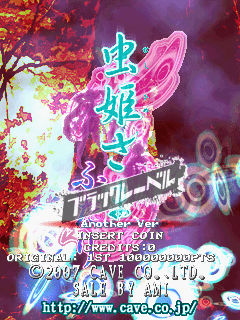
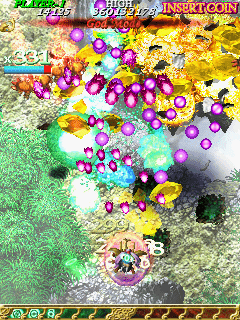
Kaneko worked with ‘Inter’ of Korea on some games, customizing them for the Korean market
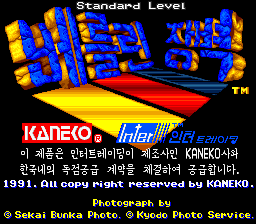
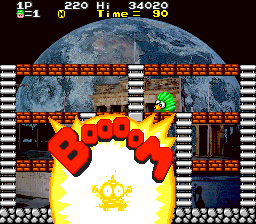
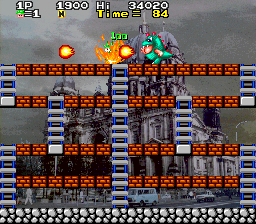
Legitimate?
Sometimes it’s really difficult to tell if a clone is a legitimate re-release / license of a game, or a hack. In some cases the only thing that actually differs between sets is a graphic rom, meaning the actual CPU is running exactly the same code with exactly the same logic. One such case that was added to MAME last year is JT-104, an alternate version of Rad Action (aka Ninja Kid 2). Various paperwork exists suggesting that this might have been a leitimate release, licensed to United Amusements, but then if you look at the actual ROM it’s simply the same program as Rad Action (containing text strings used by the game still calling it Rad Action in places) just with a replacement graphic rom. This results in a confusing situation where the title screen reads ‘Licensed to World Games’ but the intermissions (where a graphic is used) show ‘licensed to United Amusements’ My gut feeling on this one is that it’s an unofficial hack (created when the game was in the arcades) made to look official with supporting documentation. Both JT-104 and Rad Action are terrible titles however, what was wrong with Ninja Kid II?!
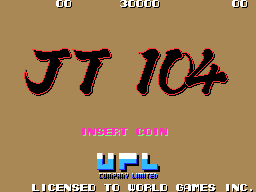

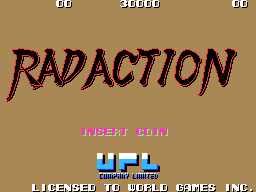
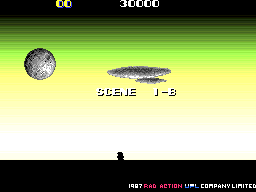
Illegitimate!
Other cases where ROMs are simply a graphic change are more obviously just hacks / bootlegs. In the early days of MAME these were simply discarded (and by the same rule / logic JT-104 featured above was discarded too) however in recent times we’ve ackowledged that some of these have a history. One such hack is ‘Candory’, a Korean release of Ponpoko with the characters changed to look like Mario. The hack is very lazy, not even bothering to change the title displayed on the screen, but a number of Korean users remember it clearly.
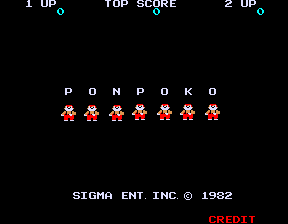
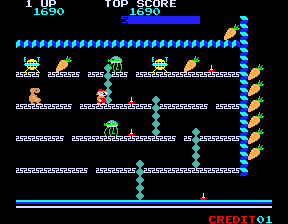
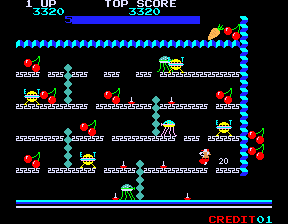
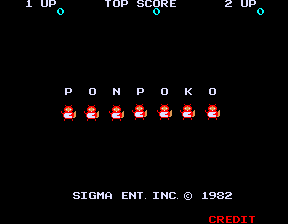
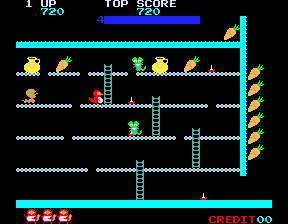
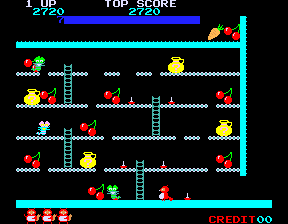
Struggling for an Audience
Gambling games and Redemption games are rather unpopular emulation targets even when they’re English language ones, non-English ones seem to attract even more ire, or at least did back in the day. They’re important to emulate however, things like Go-Stop, a Hanafuda title from a 2001 era Visco show a different side to the company that would, like many traditional developers, later go on to almost exclusively make titles of that style. The game runs on the all-in-on Seta ST0016 processor (integrated Z80, gfx, and sound) and it’s discovery filled in some blanks regarding how the sprite list is processed, possibly benefiting other games using the chip in less obvious ways.
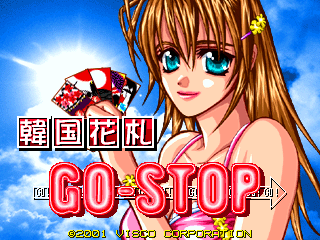
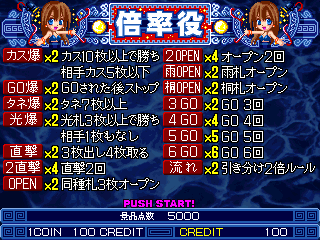
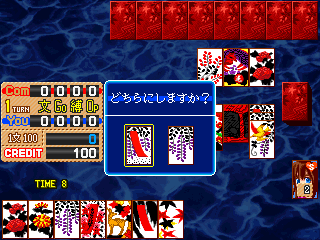
Dongfang Shenlong, previously known as ‘BMC Poker’ shows the importance of working on the emulation of these titles, had it been left unemulated it would have forever been an ‘unknown’ BMC game with poker theme (the bonus rounds) Instead, with it emulated, the correct title was identified.
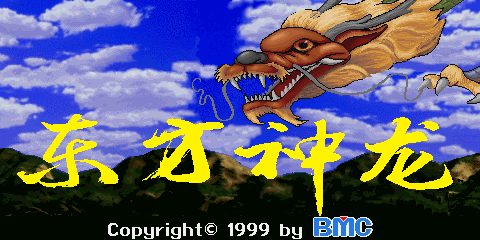
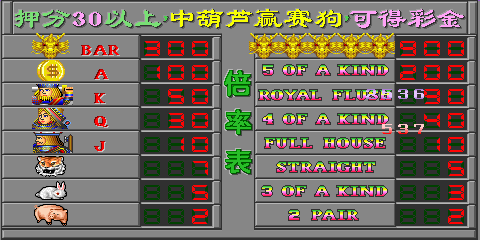
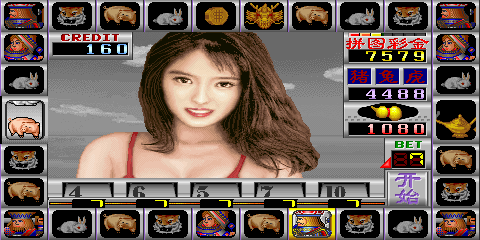
Ming Xing 100, also known as Star 100 is another gambling game, this one Chinese. I think it’s actually hacked from Lucky 8-lines, or a similar game, but tracing the exact linage of these gambling games is very difficult.
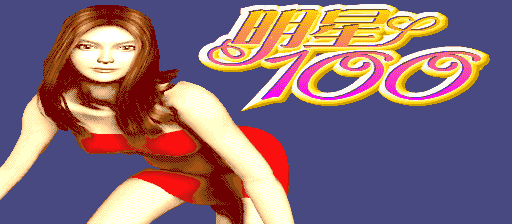

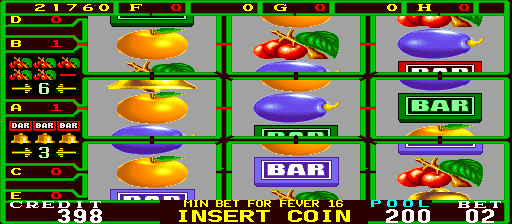
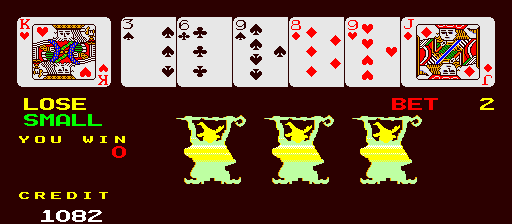
The games in the Bordun ‘Sky Lancer’ driver are no better, while most have English texts they clearly weren’t created by a native speaker. I do wonder if these are just hacks of hacks tho, again the games seem very close to Lucky 8 Lines and the like, and the quality of them is shocking. ‘Leader’ and ‘Neraidoyla’ are two games that were added / made to work in 2014, other games in the driver appear to be of Russian origin, Leader is apparently a Greek version.

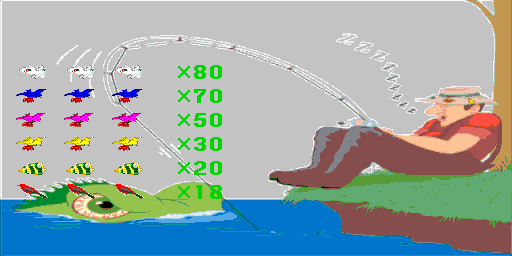
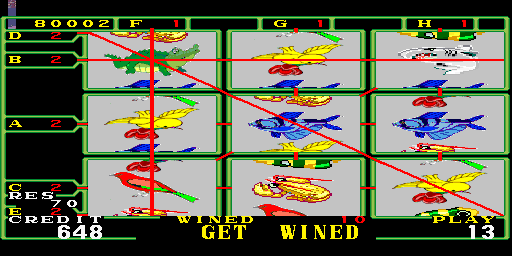
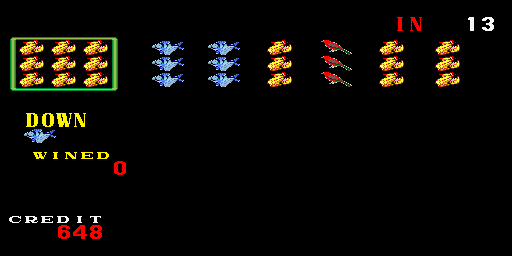
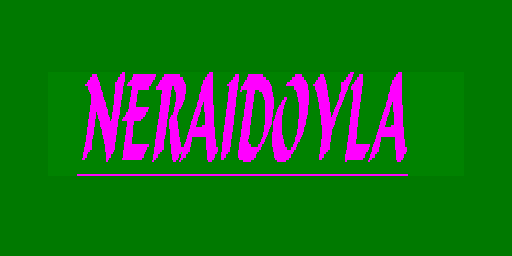

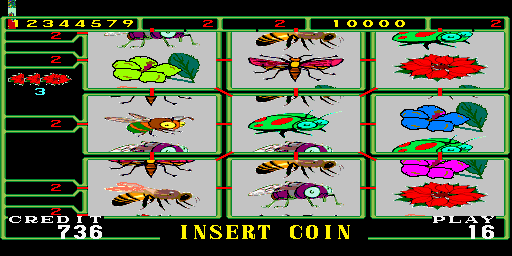

‘Gallag80’ and ‘Super Star 97’ are also basically the same thing.
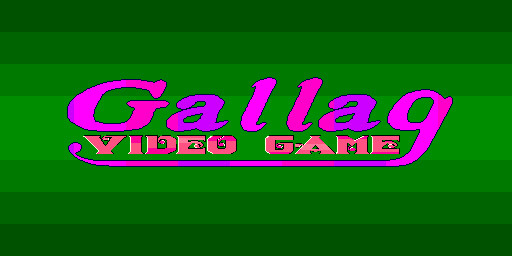
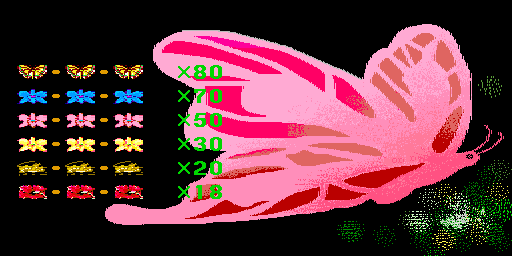
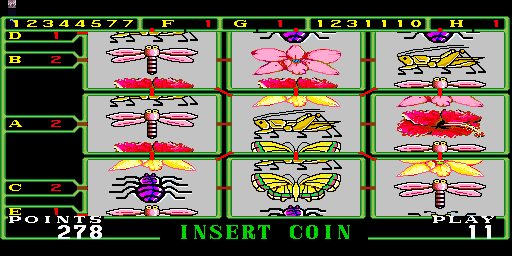
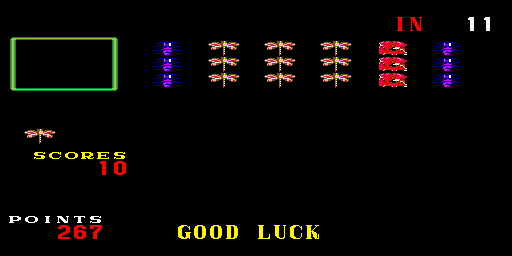
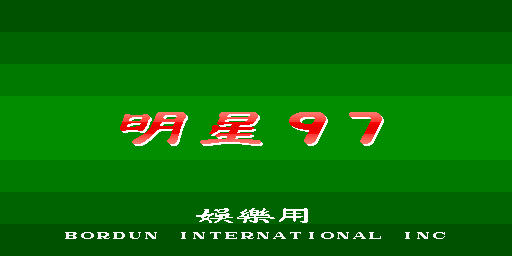
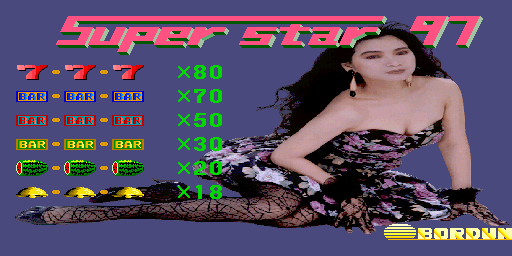
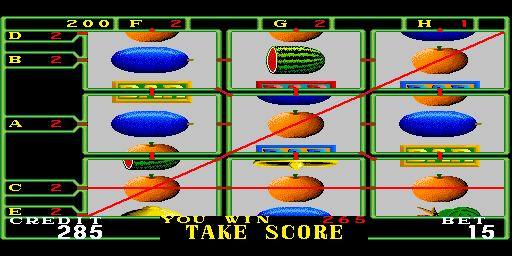
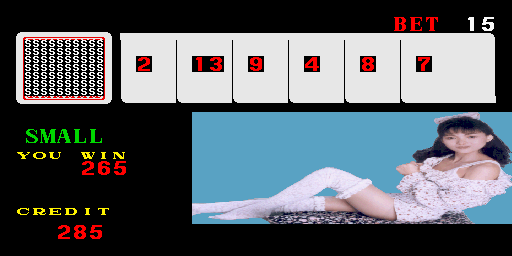
Italy has been the source of many Gambling games too, for some reason they show up quite often there, and while we can’t emulate all of them we can emulate some. Cherry Wheel was one that ended up being emulated in 2014, although it’s still marked as UNEMULATED PROTECTION because there appears to be an MCU controlling the win ratio by deciding what symbols you’re given (rather important on a gambling game)
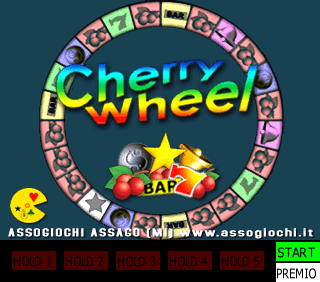
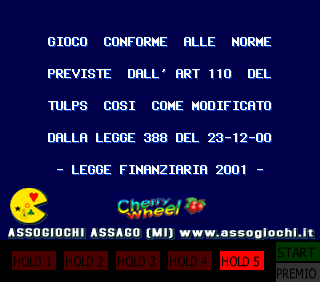
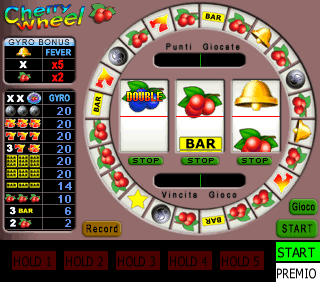
Record is another from Italy, generic looking and uninspiring.

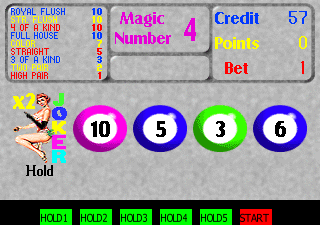
Coinmaster were a relatively well known manufacturer back in the day, although finding their games seems surprisingly tricky these days, so it was good to see a dump of their Joker Poker.
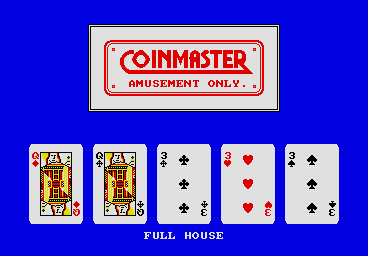

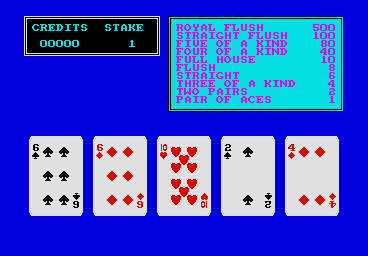
There was also a very generic ‘Double Up Poker’ from ‘Jubilee’ I’m sure it served a purpose back in the day, but it’s hardly memorable.
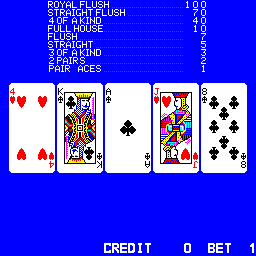
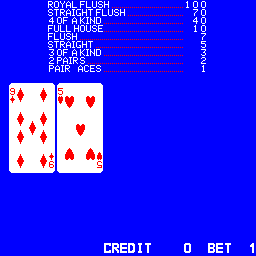
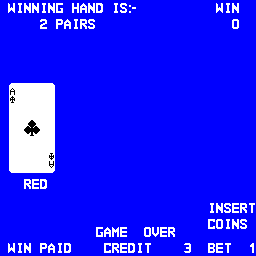
Interestingly a ‘Ranking’ version of ‘Witch’ turned up Witch is a pinball themed gambling game which I believe was produced by Excellent Systems then licensed to Sega for some regions. This ‘ranking’ version turns it into more of a traditional game with a high score table rather than a gambling game with payout, however, it’s a crude attempt to convert it as you’re still only granted 1 life (and it’s very easy to lose it instantly if the ball rebounds down the middle) and there’s a very strict time limit in which to get your points. A challenge for sure, but not really an interesting or fun game to play.
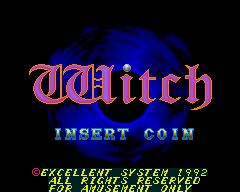
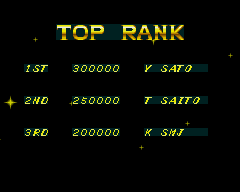
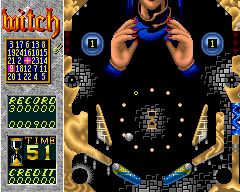
Scraping the very bottom of the barrel (and bear in mind that this barrel includes work from the likes of Comad, so is already half buried at the bottom of the Mariana Trench) we have titles from ‘The Game Room’
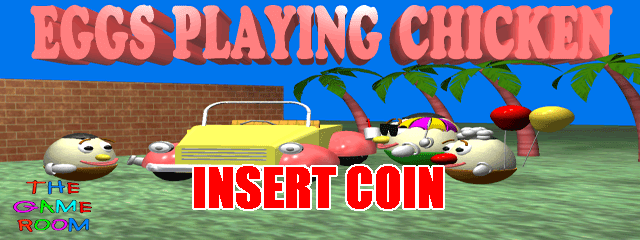
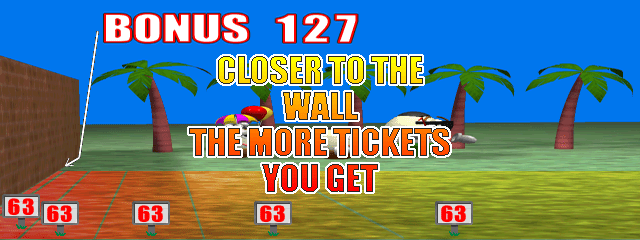
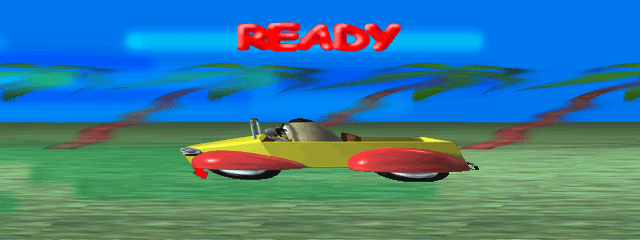
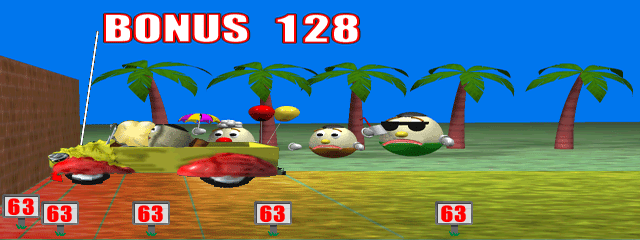
Dirty Tricks
I mentioned ‘Stealth’ games earlier, but that wasn’t the only trick the manufacturers of gambling games liked to play and I’m fairly sure the game I’m about to mention is an example of another one. One discovery in 2014 was a previously unknown title on Igrosoft’s hardware known as ‘Neo-Game Windjammer’ If I say Neo-Game Windjammer the first thing that comes to mind is probably Data East’s Standout Neo-Geo title Windjammers.
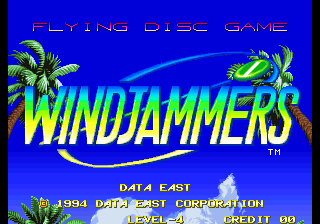

Of course, this is something else, and while the use of the word ‘Windjammer’ does accurately describe what is depicted on the title screen it is my opinion that the Neo-Game bit is intentionally misleading. Anyway, this is what Neo-Game Windjammer looks like, it’s a poker game.
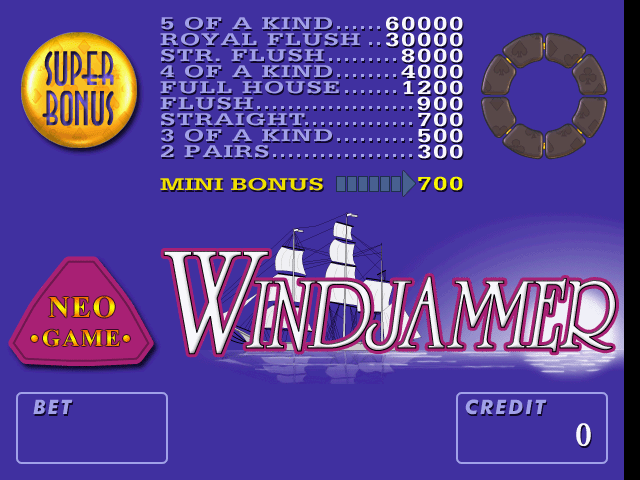

We know for a fact that some Italian gambling games were named after more famous titles (eg. Puzzle Bobble) in an attempt to prevent them from being seized as ‘known gambling games’ Sadly those ones waren’t emulated yet tho because they use an MCU for the code, with no external rom and we have no procedure to dump them (they’re not MASK parts so decap is useless)
Maybe this case was a genuine & innocent clash of names, but I have my doubts. Gallag80 featured above could also be an attempt to pass a gambling game off as a Galaga PCB.
Player’s Edge
A common theme over the last few years has been the addition of various Player’s Edge Plus sets, 2014 was no exception with lterally hundreds of clones added.
Some of them also counted as new games, for example ‘Haywire Slots’
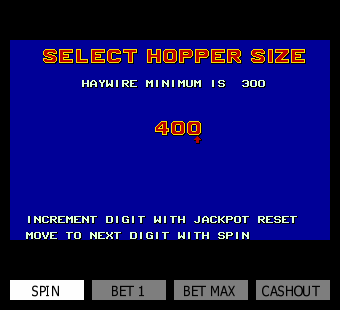
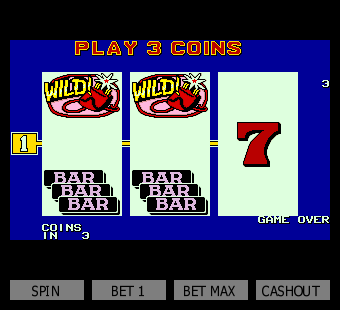
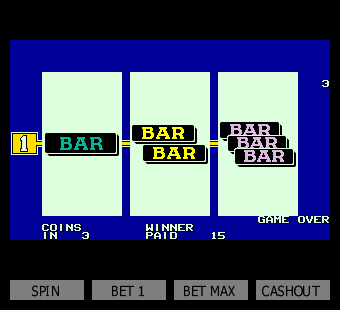
Pinball
Covering progress with Pinball titles is difficult, we don’t emulate the tables so at best (in the cases of the more modern ones) all you have to look at are the display animations and for the earlier ones you don’t even have that, just a scoreboard and some lamps. A lot of progress was made on Pinball hardware over the course of the year, and when the time does come for MAME to replace PinMAME as the emulation part of the experience we’ll be in a good position to do so. What’s shown here only covers a tiny fraction of the work which included sound hookups, video fixes and much much more.


















The video section of a number of ‘hybrid’ Pinball machines was emulated too, the most famous of these being Baby Pacman. Granny and the Gators was another on very similar hardware to Baby Pacman, but is obviously less remembered.
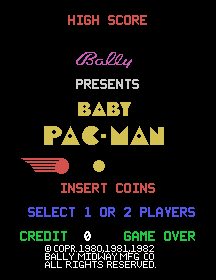
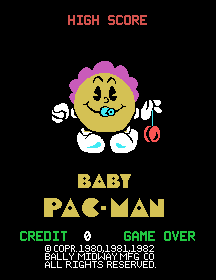
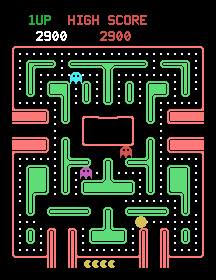

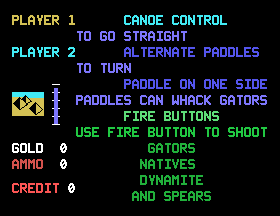
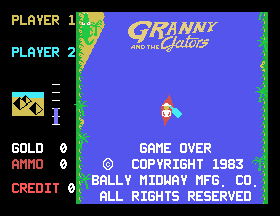
As already mentioned, plenty of work was done on other Pinball systems too, but many of them predate the period where interesting attract modes were used, instead simply displaying the score with 7-seg digits, while this work is important it doesn’t really leave me anything to show.
Misc Systems
In the MESS side of the code work was done on the emulation of the APF M-1000. As you’d expect for a system from 1978 the software available is fairly primitive,
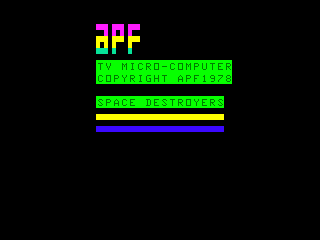
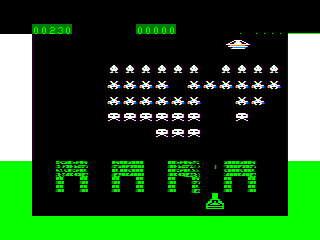

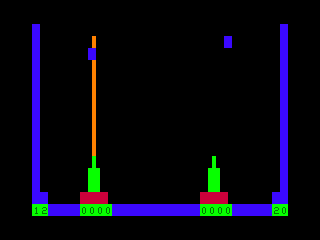
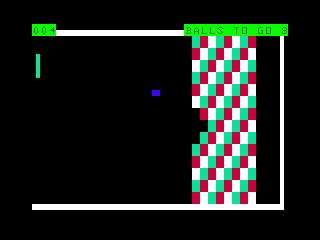
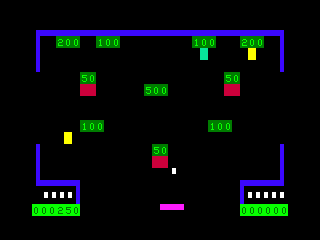
Another incredibly rare system that was first emulated in 2014 is the Bandai SuperVision 8000 (SV8000)
I’m reusing the screenshots from my original blogpost here because nothing has really changed in the emulation since then.
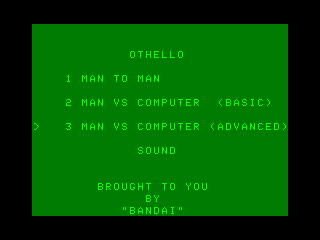
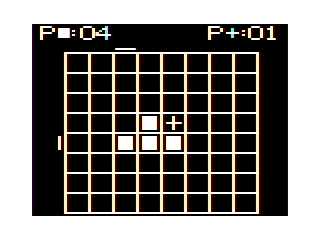

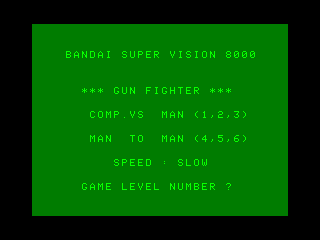
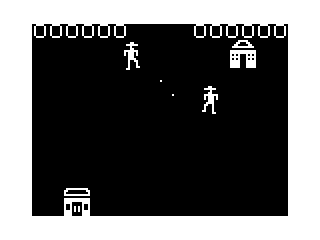
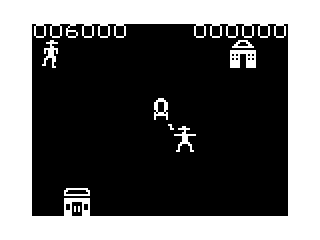
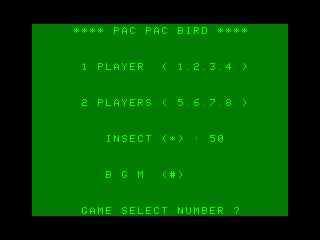
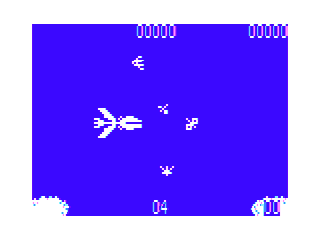
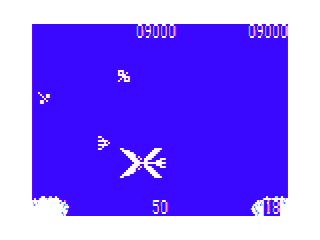
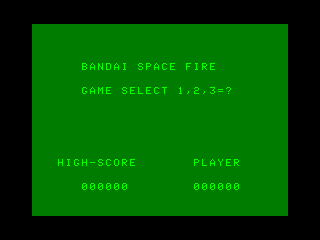
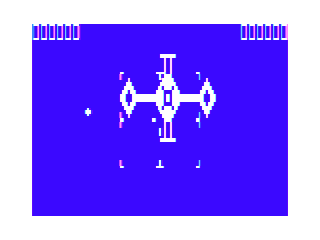
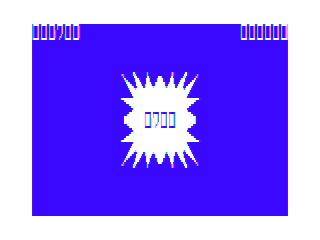
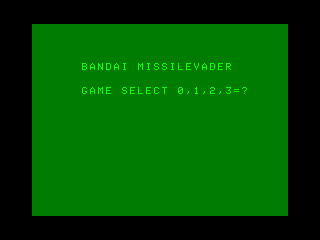
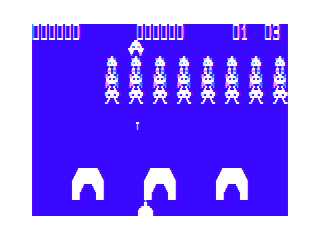
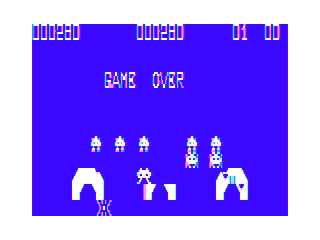
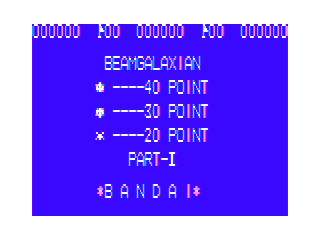
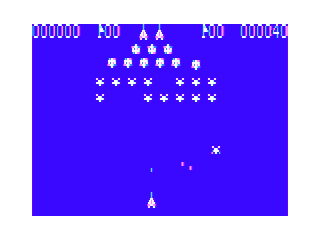
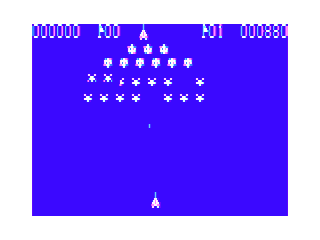
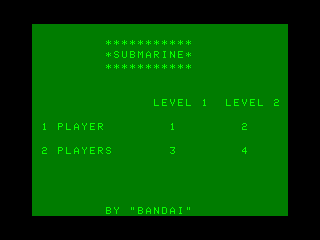

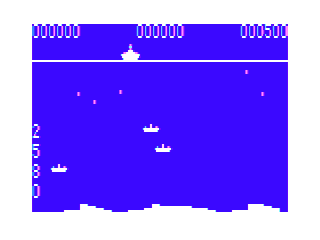
Does It Work Yet??
Sometimes one of the most difficult tasks in emulation can actually be the ‘simple’ task of deciding when something works well enough to be considered ‘Working’. We get this wrong sometimes, Strider 2 for example still has random lockups, has always had them and definitely should NOT be considered ‘Working’ (it still is at the time of writing)
Other times, especially when simulating protection (well done protection at least) it can be nearly impossible to know if you’ve properly covered all bases unless you’re intimately familiar with the game. Example in MAME of where I still feel we’re getting this wrong include a number of Taito games, even famous ones like Operation Wolf and Bonze Adventure, neither of which I really consider to be working properly, and probably won’t be 100% until the C-chips are somehow decapped / dumped and properly emulated (easier said than done)
The ‘Working’ flag ends up being a developer choice more than anything else, and 2014 saw improvements on a couple of drivers that improved significantly, but because we’re exercising caution did not yet get promoted to ‘Working’ state.
The first of the games I’m covering in this section is Puck People, aka Funny Strip, both of which are basically the same game. Puck People has something of a splash screen, not present in Funny Strip
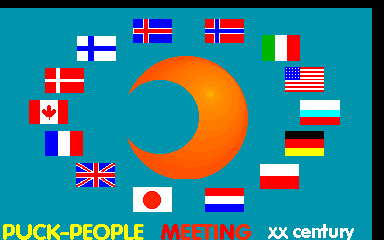
From there on in they differ only really by graphics and the bonus feature, which on Puck People is a Card game, and on Funny Strip is a low quality ‘strip’ graphic. The sound effects are all badly sampled from the original Pacman.
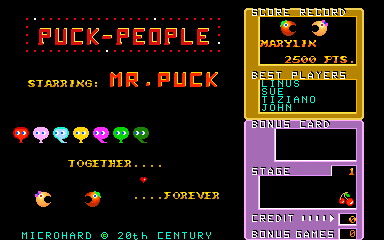

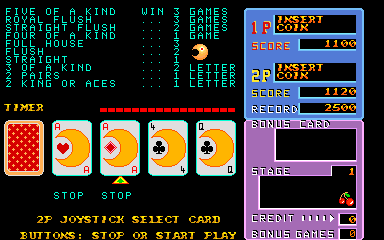
Funny Strip can be seen below
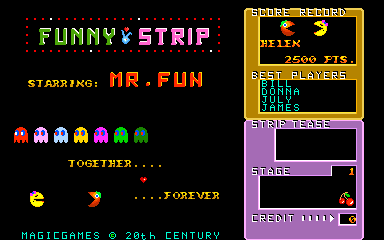
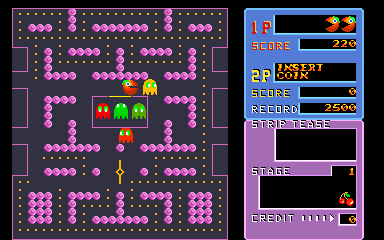
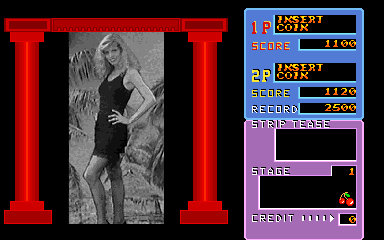
The game is terrible, I don’t know why such an effort was made to protect it!
Actually, terrible games are a prime example of where making a judgement call can be difficult, if a game plays badly, and you know it’s heavily protected then it’s easy to place the blame on imperfect emulation of the protection when sometimes the real blame lies with the game.
Godzilla benefited hugely from the Seibu COP improvements needed to make Raiden 2 work (in addition to some video fixes, although it needs more)
The interesting thing with Godzilla is that it appears to make fairly light use of the protection scheme. Galloping Ghost arcade put up a video of the game on YouTube which has been a useful reference, confirming at least the number of digits shown in the score display (one aspect of the proection) but the other part remains less certain. The only other feature of the Seibu COP protection employed by Godzilla appears to be the collision hit boxes, and, based on the fact they work perfectly in Raiden 2 (should be pixel perfect, several of the bullet patterns demand such) it seems reasonable to assume they’re correct for this game too.
As mentioned, some video priorities need fixing, as does a bit of sprite flicker, but maybe this one is actually working? It’s a horrible game to play tho, and somebody who knows the game really needs to do a full playthrough to make sure they don’t touch any other aspects of the protection later.
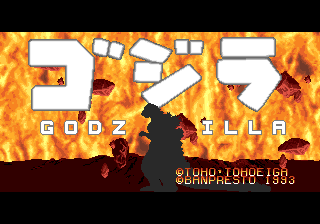
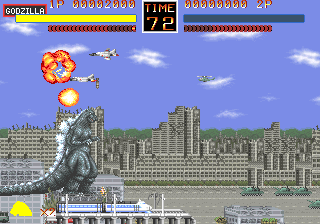
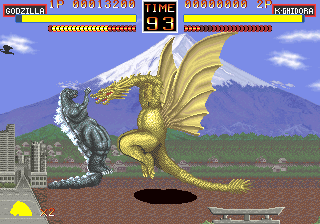
Significant Visual Improvement
Nebulas Ray (Nebulasray?) could easily be looked at as a game that was promoted to ‘Working’ state prematurely, while playable it was missing one of the most significant and attractive graphical effects of the game, the pseudo rotation of the backgrounds when you move, and the starfields. Furthermore you couldn’t get into Test Mode to change any of the game options.
These turned out to be mostly issues with the interrupts, the Rotation effect was a complex ‘raster effect’ (changing the scroll parameters on each line) as was the starfield. With those hooked up properly the game looks much better, although the raster effect is clearly off by one line, and the sprites glitch suggesting that they probably should be buffered rather than having raster effects applied to them, performance also too a nosedive trying to perform raster effects on said zooming sprites. Two steps forward, but one step back. Unfortunately there’s still a long term regression with the audio here too, with samples being played at the wrong rate and being cut off, apparently a much more complex issue than it appears on the surface (it can be fudged by changing the clocks, but the real issue is deeper)
Trying to convey this improvement through screenshots is difficult, but when you see the thing running the difference is night & day, the background ‘rolls’ as you move from left to right, and there’s a multi-layered starfield with a fake motion blur effect on the stars that rolls too giving the whole thing a tremendous feeling of depth. When you consider how simple the actual hardware is (it has no native rotation or line select capability, the tilemaps are straight from Namco System 1) then it’s a really impressive sight.
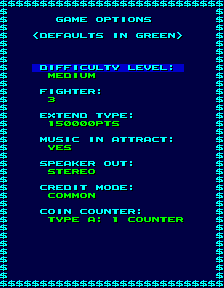
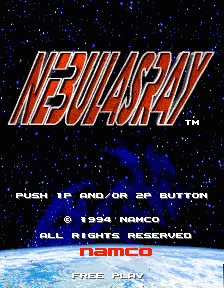
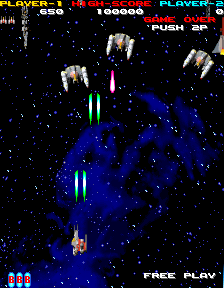

Didn’t Make The Grade
We work hard to try and get realistic targets into a working state before releases, but sometimes we simply run out of time, or run out of ideas, or put things a little further down on a todo list than some users would like. This section of the writeup could give a glimpse of what might end up being worked on a bit more in 2015.
Converting home console games for arcade use wasn’t unheard of for popular titles, we’ve seen several Genesis and SNES ones in the past, including the Gundam Wing game mentioned earlier in this article, however in most cases these games have a little extra protection when compared to their console counterparts, which can slow the emulation progress. One such game that was located in 2014 is a bootleg of Sonic the Hedgehog 2 for the Genesis / Megadrive running on the same PCB as the Aladdin bootleg located some years earlier.
The problem with this one is that it boots with 2 coins already inserted, and no ability to insert coins, also you’re given a single life, and the timer has been hacked to give you about 15 seconds to complete the level (which, believe me, is impossible) I assume the timer speed is somehow adjustable by dipswitches, and the credits handled by some kind of protection device (like Aladdin) but nobody found the time to look further at it. The game replaces the Sonic icon on the lives display with the number of credits, and takes out the 2 player options / interlace mode part of the attract demos. With a little effort I’m sure this one could be made to work, there aren’t actually many code changes from the Genesis rom.
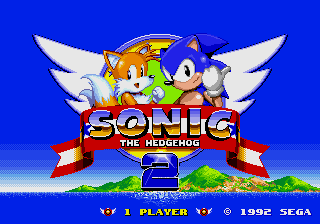
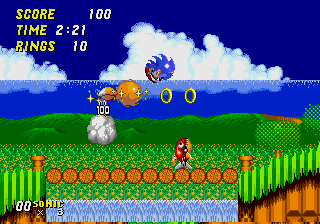
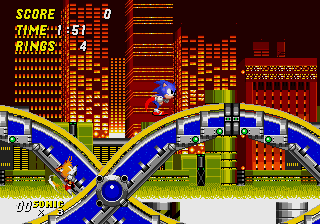
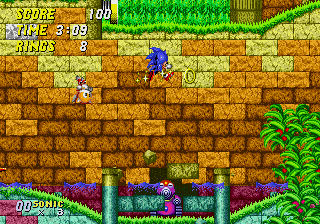
Club Pacman is one of the Pacman games released / bootlegged in Argentina featuring ‘Double Command’ mode, this means that 2 Pacman characters operate in the maze at the same time. It doesn’t seem anywhere near as polished as the undumped ‘Ms Pacman Twin’ and tends to glitch out a lot, also I didn’t figure out how the controls multiplex, so for those reasons it’s still marked as NOT working..
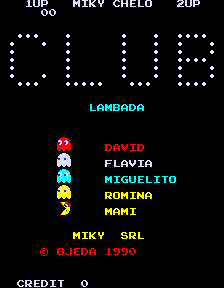

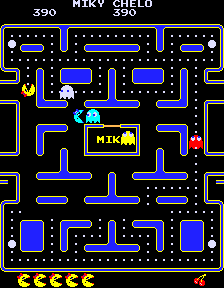

While Crystal System based game Top Blade V was promoted to working in 2014 the other games on the platform didn’t make it quite that far. We did see progress, but the games still randomly crash. It’s a shame these don’t work, Donggul Donggul Haerong looks like an interesting Wonderboy inspired game, and Office Yeo In Cheon Ha is a good looking Bishi Bashi clone, however debugging the problem is fiendishly difficult.
No work was done on the other game using similar hardware, P’s Attack. Unlike the others that uses a CF card acting as a drive for the game and It’s *possible* the CF dump on that is bad as it was dumped at a time when CHDMAN was less reliable.
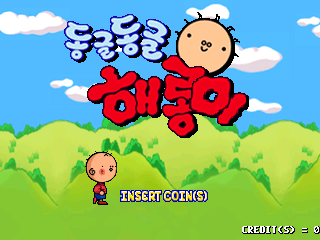
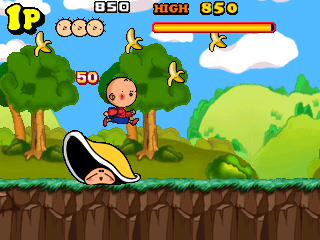
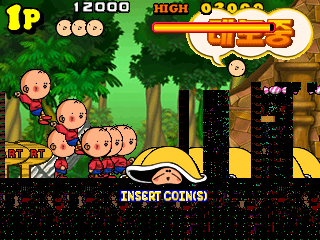
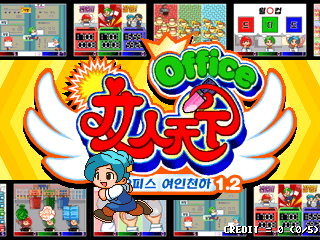
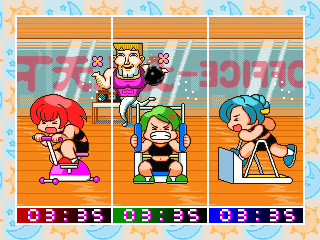
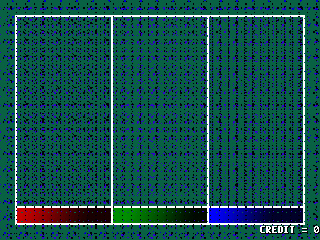
Race Drivin’ Panorama was another to prove frustrating, after the initial euphoria of managing to get all the screens hooked up and communicating, and a couple of test runs which seemed to indicate the game worked fine I found that the side views crash when selecting one of the car types. Ordinarily I might have written this off as a bug in the prototype, but there are accounts online of that car working fine, just with no dashboard graphics for the side screens. Annoying.


Cosmoswat is a unique projection based game from Namco, however the dump has various bad roms making emulation/simulation of the rest of the hardware rather pointless for the time being.
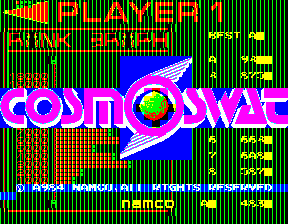
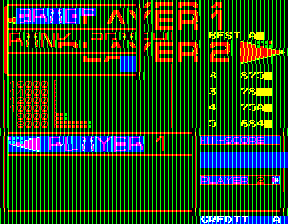

A Spanish game called “Cuatro en Linea” also saw progress stall rather early due to an unknown custom device used by the game and CPU communication issues.
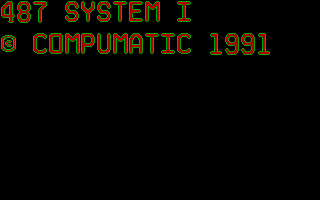
Not everything added to the MESS Software Lists works yet either, the Mega Duck title Duck Adventures was added, but ingame graphics are corrupt.
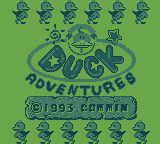
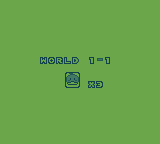
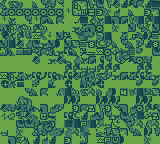
Another one of the additions to the Sord m5 list also has issues, Adidas Lucky Shoot is a very rare title, but I can’t see a way to make it progress past the title screen.
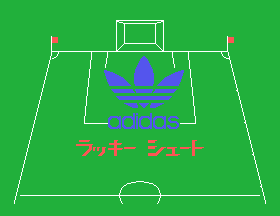
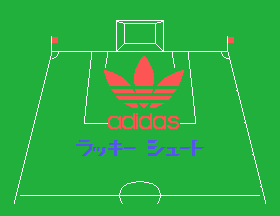
The Link / Communication version of Power Drift was also dumped, but it doesn’t work, I have a feeling it actually needs multiple units emulated in order to funciton.
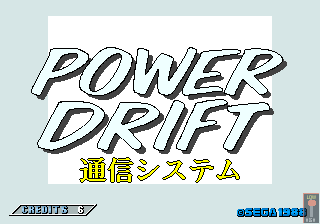
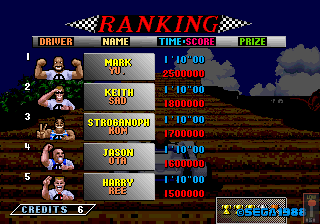
Some way off..
Sometimes new things get dumped for platforms we really only partially emulate – they show a couple of interesting things, and one day they’ll probably work, but for now they’re not especially interesting. Angler King from Namco is one such example, it boots, goes through some test screens, then complains about the I/O board.


Nothing to Say
A lot of the progress seen in the MESS side of the project is, as always, difficult to really write about of promote properly if you don’t know much about the systems. It is however all very worthwhile progress. In some cases the developers of drivers aren’t helping things because no Software Lists are added, which means knowing exactly what software I should even be attempting to run in the drivers is difficult.
One example of this, where a lot of work was done over the year, including basic floppy hookup is the Excalibur 64, without a software list however all I can easily show you is a shot from the system BASIC.

The BBN Bitgraph is some kind of Terminal, not yet marked as working (doesn’t seem possible to input anything into it, but maybe I just don’t know how to use it)

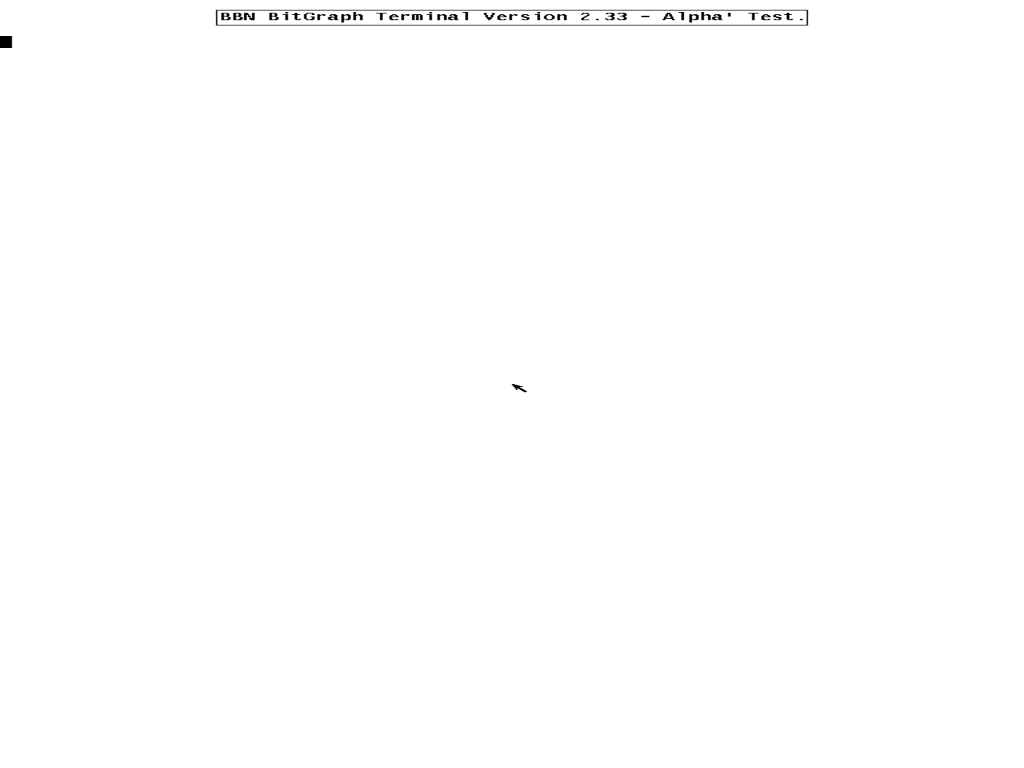
Work was also done on the Victor 9000, although it also remains in the NON-working category, locking up the emulator shortly after the screenshot shown. (This is attempting to boot CPM from the software list)
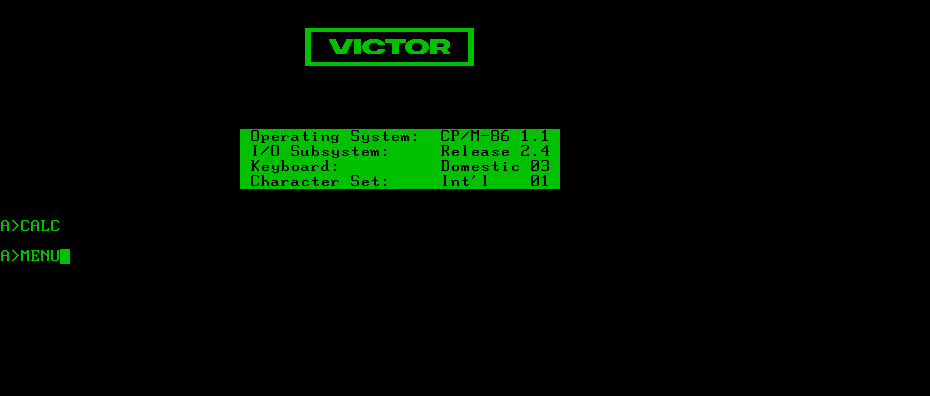
Hewlett Packard is a more household name, although the system in question less likely to be known, but which saw preliminary emulatoin is the HP16500, currently fails some of the POST tests.
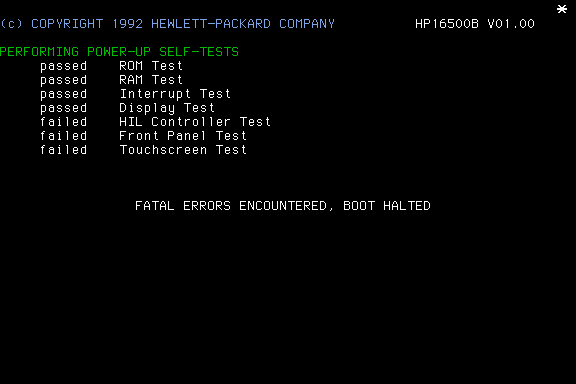
The Husky Hunter 2




The Sun 3x/80 shows some POST screens but goes no further
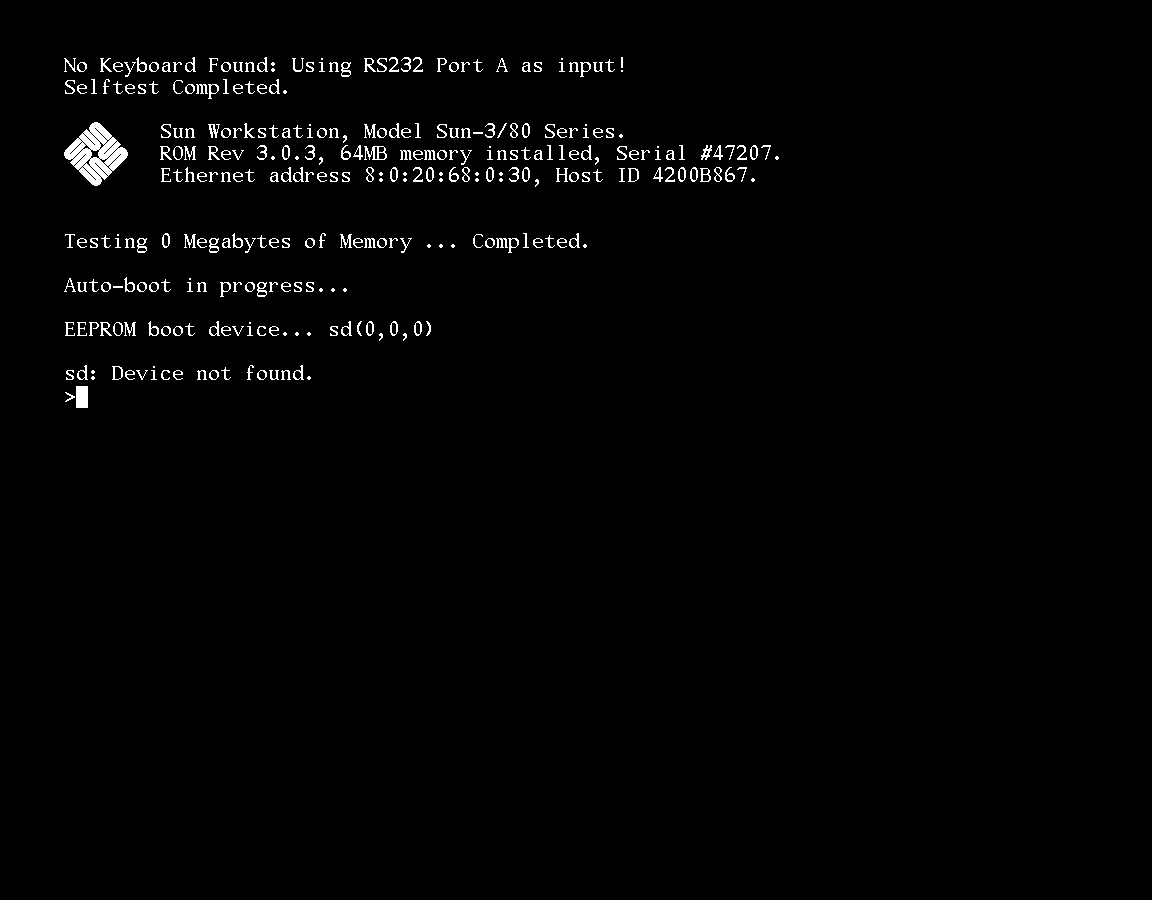
The System P Model G shows a boot screen..
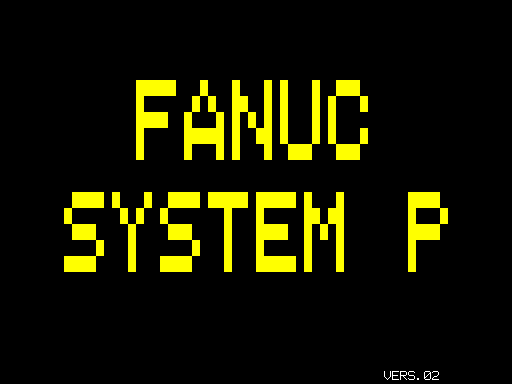
The Commodore LCD runs fairly well, although does seem to miss keys if you type too quickly (although I’ve found that common to many things in MESS, might just be how they are)



Little Regression Fixes
Even popular drivers can regress from time to time, and sometimes such bugs aren’t noticed for a while despite the popularity of the titles. Air Gallet in the cave.c was showing broken graphics (a missing background) in attract mode, and had been for a while, 2014 saw it fixed up again.
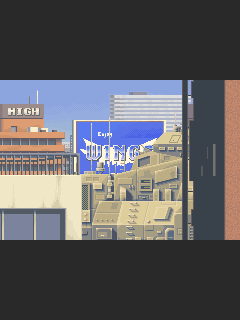
At some point during past refactoring a couple of Atari games developed visual issues, of note was 720 degrees, the classic skate park game; sprites would flicker annoyingly and it definitely didn’t happen on the PCB. The problem actually turned out to be something really really simple, it’s fixed now. The catalyst for getting this one fixed turned out to be a similar problem with flickering graphics in the Paperboy service menu!
None working drivers can regress too, Gals Panic II continues to defeat us, but at some point the Special Edition version had stopped booting entirely, even for drivers marked as NOT WORKING it helps to try and prevent them from getting worse, so that was fixed.
There are also very rare cases with MAME where fixes don’t make it in, even if they get credited, or, the wrong versions of a piece of code gets submitted and it goes unnoticed for years. That was the case with Konami’s Cuebrick, where the colours had actually been fixed years ago, but somehow the wrong code had made it into the source!
A regression with Black Tiger’s priorities was spotted and fixed. It took a while for this one to be spotted because you have to get to stage 4 in order to observe the sprite priority issues with the bridge.
Gradual Improvements
Improvements to the C64 emulation allow things like Bounty Bob Strikes Back to load from floppy.
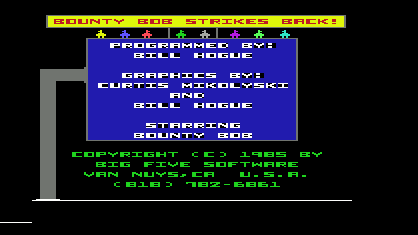
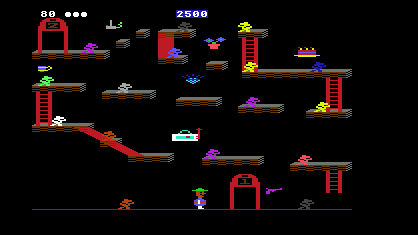
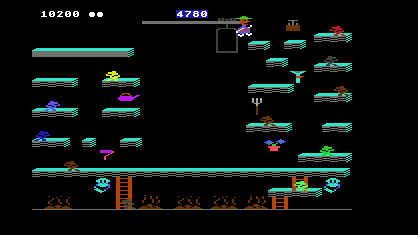
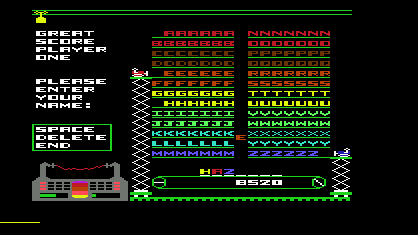
The emulation of the PC9801 video chip was also improved fixing some issues with Quarth and Xevious amongst others (running in the pc9801ux driver)
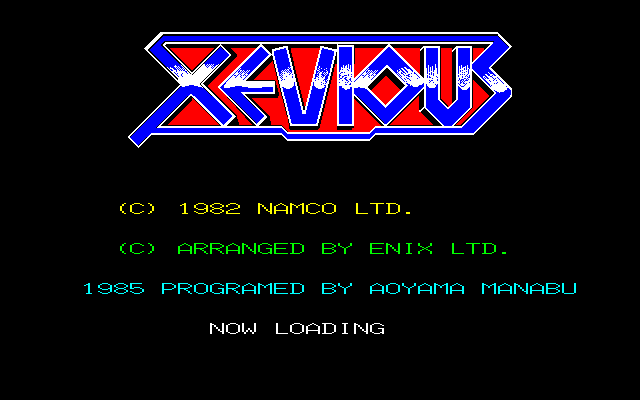
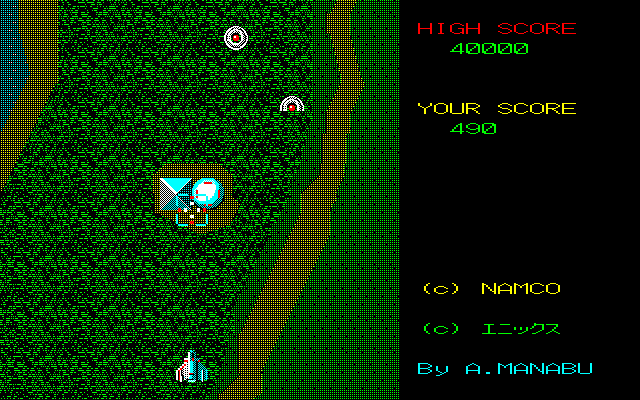
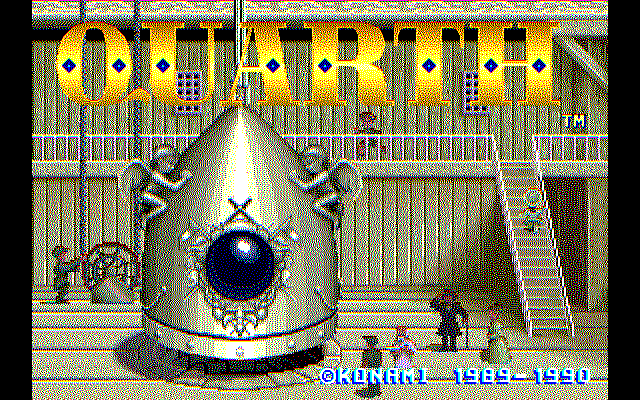
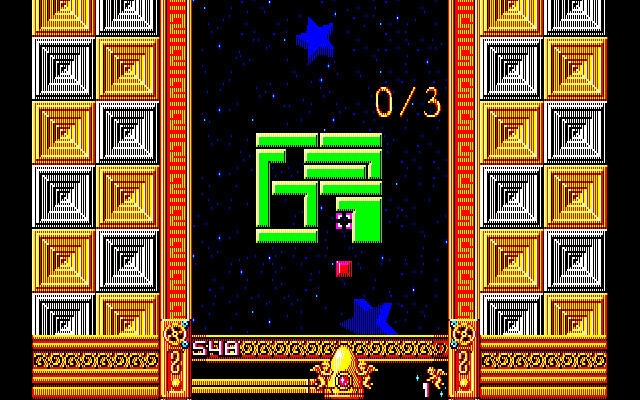
NES ‘mappers’ (the extra hardware found in NES carts) are another never-ending task to support and improve as new findings are made. Improvements in 2014 saw the Hard Drivin’ prototype improved, which you have to say was a rather ambitious title to attempt a NES conversion of in the first place.
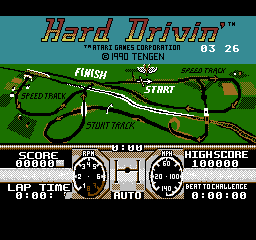
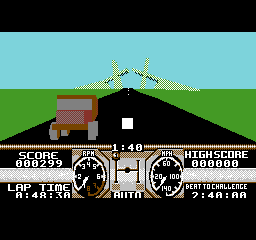


New dumps often tell you new things, and a dump of the rare ‘Jong Kyo’ for the Sord m.5 told us that we need to mirror the inputs, otherwise the game can’t be controlled. It might be a mahjong game, but having rare software like this dumped is just as important, if not more important than a lot of the other things covered in this writeup.
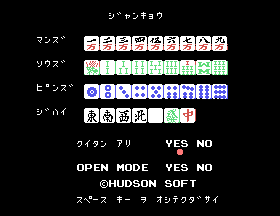
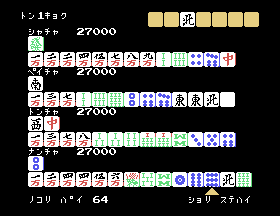
The Tiger game.com driver was also improved, allowing Centipede to be played, Frogger also runs much better (but the collisions seem to be incorrect) The Wheel of Fortune games can also be played, although there’s no internal cursor, so you have to run MAME windowed with mouse capture disabled to see where you’re clicking which is a bit inconsistent with other clickable systems.
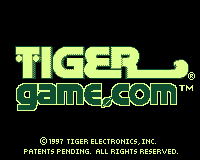
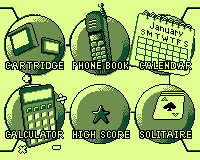
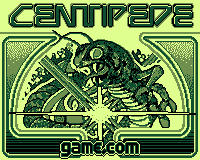
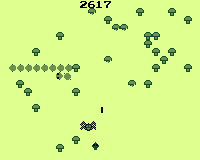
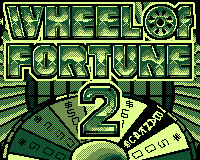
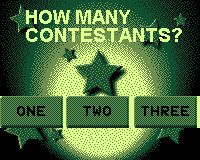
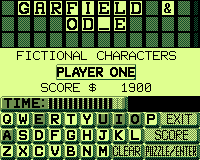
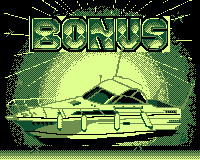
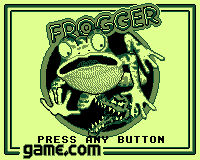
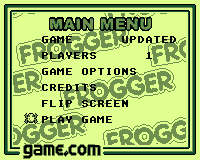
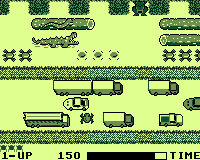
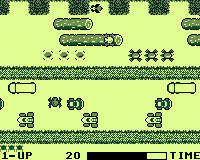
Text layer colours were improved in Taito’s Chase Bombers, although the driver still has a long way to go before it can shake the imperfect graphics tag it has.
Konami’s Rock n Rage also saw colours improved, we’d managed to mix up the PROMs for sprites/tilemaps. The cars that drop bonus items are now correctly coloured red.
The Atomiswave emulation was improved slightly, allowing more games to boot. A ‘protection’ feature that was previously missing means that you can now boot the Samurai Shodown and KOF game on the platform, very, very slowly of course!
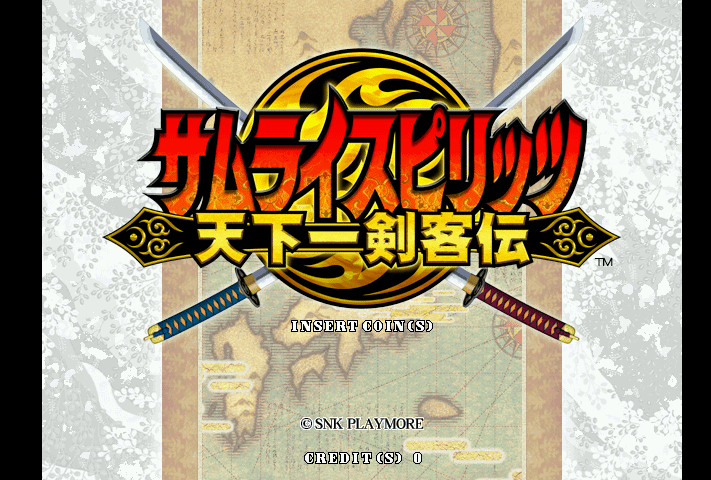
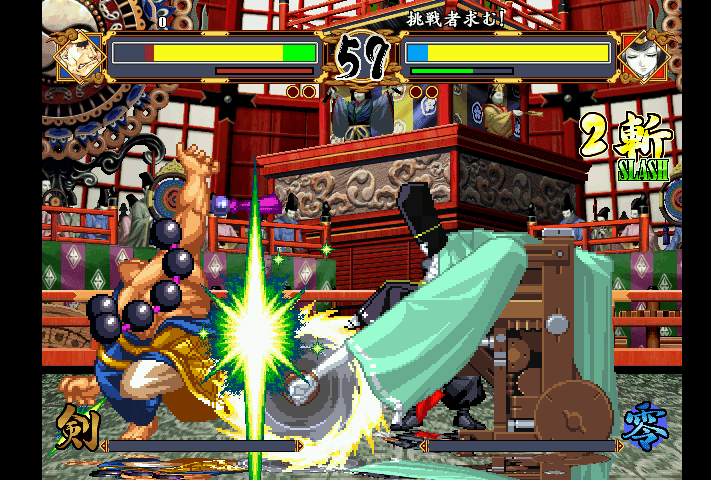
Doing things the ‘Right Way’
One thing with other emulators is they often cheat and hide the gory details of some systems, even simple ones. If all you care about is playing a game then this can work in your favor, however, in order to document how things actually worked it is important to also emulate things properly too.
For this reason the NES add-on known as the ‘Aladdin Deck Enhancer’ for which Codemasters released a number of games was split into an additional device, requiring you to plug that into your virtual NES before plugging in one of the games that was available for it. Only a handful of titles were released, and due to underlying problems with the NES emulation in MESS not all of them work, but they now exist in their own Software List rather than being incorrectly grouped with the regular cartridges.
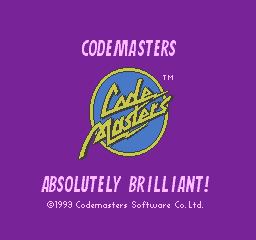
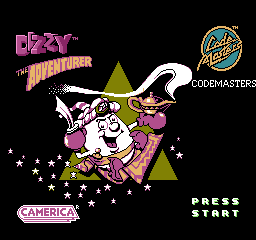
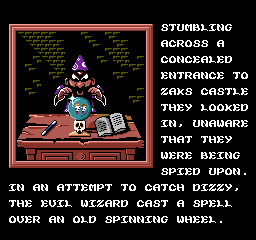
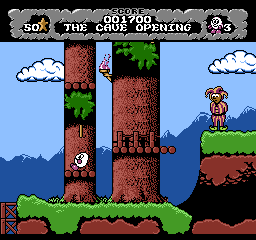
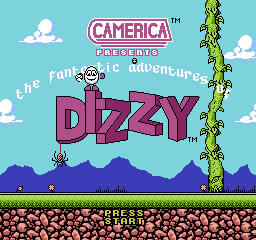
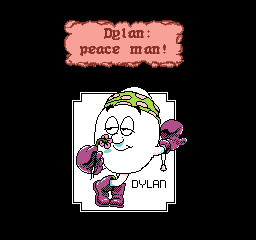
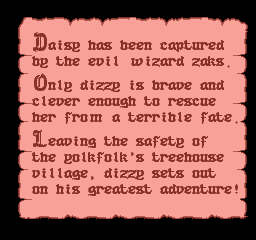
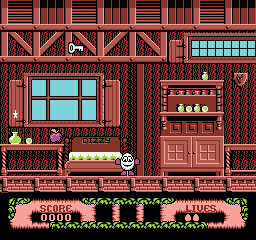
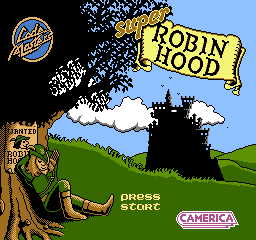
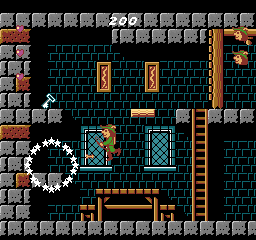
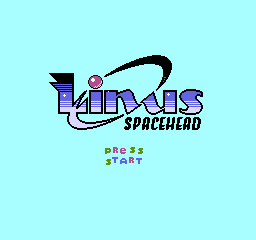
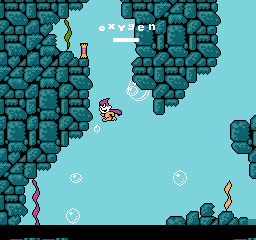
Another sign of things being done the WRONG way is ROM patches, and devices / cores for the same thing that aren’t being shared between systems due to implementation specific details. In MAME we saw a number of drivers have ROM patches removed, including some extensive work on the Touch Master driver leading to a much cleaner implementation of the security features.
Brick Zone also had some range specific patches removed, the encryption device present in the CPU module could be flipped between two states, that is now emulated rather than specifying ranges of decrypted code for each state.
Unexpected Obstacles
Sometimes when one piece of progress is made it reveals a new challenge almost as big as the initial one, this was the case with the IGS036 decryption, used by the PGM 2 platform. After the ROM code for the games was decrypted it turns out that they not only use an Internal ROM (as was expected, it remains to be seen if it can be extracted) but also that it uses an ARM type we don’t even emulate yet, with added instructions etc. meaning that understanding the system to the point needed to try and even attempt to extract the internal ROM is much more difficult than expected leading to no actual visible progress. It might still remain an impossible task if the internal ROM is secured, but we won’t know that for a while longer now.
Seibu Revisited
I opened this writeup with coverage of the Seibu progress on Raiden II and New Zero Team and didn’t really want to distract readers with a commentary on some other improvements to the Seibu emulation. Godzilla I’ve already mentioned a little earlier because it might actually already be working, the rest definitely aren’t for a variety of reasons, but they have improved.
The original Zero Team uses a number of unhandled protection commands relating to the movement of sprites in addition to the sort DMA which is not correctly implemented. We have seen improvements to the emulation of it over the course of the year but it definitely isn’t yet ‘working’ as Boss movement is especially bad. Unfortunately a lot of incredibly stupid people seem to be running MAME builds with our warning messages disabled these days and instead of realising that the original Zero Team isn’t yet working and running Zero Team 2000 instead, are running this broken version and getting a sub-par experience. The ‘nags’ are there for a reason, namely to help you.
Legionnaire benefited from the improvements to Zero Team and Raiden 2 with the hitboxes now working correctly, if you punch left you attack to the left, if you punch right you attack to the right, same for the enemies. It however suffers from worse movement issues than Zero Team with many enemies simply walking out of the play area, I know why this is, and it seems to be a difference in how some data is fetched by the COP on the 68k games (maybe configurable)
Seibu Cup Soccer suffers from a problem where all the players simply run off the field, but we have seen other improvements, the radar is now working correctly for example. The players running off the field is actually the same issue as Legionnaire with the enemies walking out of the screen space, however if I fix it the players simply don’t move instead, so there’s more to it.
“SD Gundam Sangokushi Rainbow Tairiku Senki” can be played to the end now, previously the ‘drill’ boss would leave the screen and never come bask. The visuals on that boss are a little glitchy still but it does set bits we don’t currently make use of when doing the sprite DMA, almost certainly related. The score display is currently broken because there is something wrong with our digit conversion code, it needs investigating further and writing in a way that keeps all games happy.
Heated Barrel should have improved collisions, and improved behavior of heat seeking missiles, but still randomly crashes with an address error after a few levels, this one is especially annoying as it feels so close to working.
Conclusion
The idea that MAME is ‘done’ is a ridiculous one, yes, the Seibu progress is definitely the most noteworthy progress of the year for a lot of people but you’ve only got to look over this article and see the number of things that are highlighted as needing more work to see that even in the additions made over the year there is plenty left to look at and revisit and if you factor in all the things from previous years that still need attention then there is a lot still to be done, even for popular systems. That is of course no guarantee that any of that work will be done soon, much of it at this stage requires extensive research with the real hardware rather than just being things that can be worked out by staring at logs and memory register dumps so as a result progress on them is likely to be slower.
(as the article is still in progress, no FINAL conclusion has been written yet)
very very interesting write up, as usual on this blog I’d say :) Can’t imagine how long it took to write it…
Researching it properly takes more time than I would have hoped, scanning all the whatsnew texts, git/svn logs, and MAMEINFO type files, then in some cases having to understand a few things about the systems.
This article definitely isn’t up to the standard of the 2012/2013 ones, there are quite a few areas that really deserve more expansion, however even just filtering through all the data I have in order to decide what is / isn’t worth mentioning as far as end users are concerned was eating up more time than I really had available, so I decided to publish in this state. I know I can always come back to these later and fill in the gaps.
While probably not THAT interesting to a lot of people I also wanted to give a strong focus on the things that hadn’t seen coverage anywhere, the progress on those German card games for instance wasn’t really even clear from the logs unless you knew which games used the chips where the emulation was being improved so highlighting them, even if they’re not good games, was a priority.
There are definitely more clones worth talking about, more emulation of toys, more rare console-side stuff, more obscure systems, and more improvements to our existing ones, especially when it comes to add-on hardware being emulated. You could argue this covers the bits people are going to recognize most / be looking for if looking to see what progress we made, but I always liked these write-ups to go a little further.
This is another great article !!
The games I miss the most from MAME (in working state), are the American Laser Games ones. Do you know the status of those ones ? I know they user laserdiscs and commodore amiga hardware.
Why you do not publish the 2015 artilcle “becoming one”?
If is not complete you can write a note at his end.
pleaseeeeeee….. :-)
I’ve unlocked it, although it really doesn’t cover the non-arcade stuff yet, nor is it as well organized as this one. Simply haven’t had time.
We forgive you!!! :D thank you